Executive Summary
The 2019 Asian American and Pacific Islander (AAPI) California Workers Survey, a landmark survey conducted jointly by PRRI and AAPI Data, provides a portrait of the working lives of AAPI Californians via a survey of 2,684 AAPI California residents. For the purposes of this study, respondents are classified as “working and struggling with poverty” if they meet two criteria: 1) They are currently employed either full or part-time or are unemployed but still seeking employment; and 2) They live in households that have an adjusted income that is 250% or less than the U.S. Census Bureau’s Supplemental Poverty Measure, adapted for regional location in California.
Asian Americans and Pacific Islanders (AAPIs) are an important and fast-growing part of the California workforce. They have been the fastest-growing racial groups in California since 2000, with immigration fueling much of the growth. Although statistical averages show that AAPIs as a whole exhibit relatively high levels of employment and earning power, this report reveals significant areas of concern. Like for the rest of the population, we find a state of “two Californias” among AAPIs—one where some AAPI workers report a great deal of financial stability and one in which other AAPI workers report significant financial insecurity and struggle. This report reflects the findings of the first comprehensive survey of AAPI California residents, with a special focus on those who are working and struggling with poverty. The report provides a broad portrait of their opinions and experiences.
Nearly one in four California AAPIs are working and struggling with poverty. For some groups, the proportions are much higher.
- Nearly one in four (23%) AAPIs in California are working but struggling with poverty; 37% are working but not struggling with poverty, and 40% are retired, students, or otherwise not working.
- Among AAPI workers in California, 38% are struggling with poverty, while 62% are not.
- There are significant differences among AAPI ethnic groups:
- Hmong (44%) and Native Hawaiian and Pacific Islander (36%) Californians have the highest proportions of their populations who are working and struggling with poverty.
- One in five or more Cambodians (26%), Vietnamese (26%), Chinese (23%), Filipinos (22%), Japanese (22%), and Indians (20%) are working and struggling with poverty.
- Among AAPI groups in California, Koreans (15%) are the least likely to be working and struggling with poverty.
- Importantly, no AAPI group is exempt from the struggles facing Californians: the relatively large numbers of Chinese, Filipino, Indian, and Korean Americans in California mean that they, too, are well-represented among the millions of Californians who are struggling with poverty. For example, Chinese (30%) and Filipinos (24%) account for a majority of AAPI Californians who are working and struggling with poverty.
- The San Joaquin Valley (50%) and Inland Empire (37%) regions have the highest proportion of AAPIs who are working and struggling with poverty.
More than one in ten AAPI Californians work in the “gig economy.”
- Overall, 14% of AAPI Californians report participating in the gig economy last year, defined as being paid for performing miscellaneous tasks or providing services for others, such as shopping, delivering household items, assisting with childcare, or driving for a ride-hailing app.
- AAPI workers who are struggling with poverty are about twice as likely as workers who are not struggling to report participating in the gig economy last year (24% vs. 15%)
- Native-born AAPI are almost three times as likely as foreign-born AAPI Californians to work in gig-economy jobs (26% vs. 10%).
- Among AAPI subgroups, Native Hawaiian and Pacific Islanders (30%) are more than twice as likely as AAPI Californians overall to participate in the gig economy. Additionally, AAPI residents of San Joaquin Valley (36%) are much more likely than residents of any other region to participate in the gig economy.
AAPI Californians remain somewhat optimistic about the existence of the American Dream and the California Dream, but question the “bootstrap” narrative.
- A majority (62%) of AAPI Californians believe the American Dream—that if you work hard, you’ll get ahead–still holds true. Majorities of both those who are working and not struggling with poverty (56%) and those who are working and struggling with poverty (56%) believe in the American Dream, although both groups are less likely to say this than those who are not working (70%).
- Notably, some degree of immigrant optimism seems to be at work here. AAPI Californians who are born outside the U.S. are more likely than those born inside the U.S. to believe the American Dream still holds true (69% vs. 43%). Groups with a lower proportion of foreign-born members—such as Japanese, Hmong, and NHPI—express the lowest levels of belief that the American Dream still holds true today.
- Only four in ten (39%) AAPI Californians believe that it is harder to achieve the American Dream in California than elsewhere in the U.S.; most believe it is either easier (31%) or the same (24%) as elsewhere. There are no significant differences in opinions between AAPI California workers who are struggling with poverty and those who are not.
At the same time, despite displaying higher levels of financial security and optimism than the average Californian, a majority of AAPI Californians question the “bootstrap” narrative that “hard work and determination alone” guarantee success for most people.
- A majority (55%) of AAPI Californians disagree that “hard work and determination alone” guarantee success for most people.
- About two-thirds of AAPI Californians (64%) working and struggling with poverty, compared to a smaller majority (54%) of AAPI workers who are not struggling with poverty disagree with this bootstrap narrative.
AAPI Californians report facing a range of economic hardships, as well as racial discrimination.
- More than eight in ten (82%) Native Hawaiian and Pacific Islanders report that they experienced at least one of ten possible economic hardships, like being unable to pay a monthly bill or having to use food stamps, as have about seven in ten Hmong (76%), Cambodians (71%), and Vietnamese (70%).
- Japanese (55%), Chinese (53%), and Koreans (52%) are significantly less likely to report experiencing at least one economic hardship.
- AAPI struggling workers are significantly more likely than non-struggling workers to have experienced at least one of these issues (77% vs. 59%) or to have experienced four or more of these issues (40% vs. 13%).
- AAPI Californians are more likely to report dealing with racial discrimination than Californians overall (17% vs. 12%, respectively).[1]
- Among AAPI subgroups, experiences of racial discrimination are highest among Native Hawaiians and Pacific Islanders (29%) and Indians (24%).
AAPI Californians who are working and struggling with poverty are more likely than workers who are economically secure to report that they or someone in their household have experienced a variety of negative workplace experiences in the past year.
- Four in ten (41%) AAPI Californians report that they or a member of their household have experienced at least one negative workplace experience in the past year.
- AAPI workers who are struggling with poverty are more likely than non-struggling workers to have been required to work overtime without being paid for it (25% vs. 16%), to be paid less than the minimum wage (20% vs. 5%), or to have had their wages withheld by their employer (14% vs. 5%).
- Combined, 35% of AAPI Californians who are working and struggling with poverty report experiencing at least one of these forms of wage theft in the last year, compared to 19% of non-struggling workers.
Most AAPI California workers feel replaceable.
- More than six in ten (63%) AAPI Californians say that employers generally see people like them as replaceable.
- AAPI workers who are struggling with poverty (70%) are roughly as likely as more financially secure workers (64%) to say that employers generally see people like them as replaceable.
AAPI Californians who are working and struggling with poverty tend to believe that the deck is stacked against them economically, but a significant minority also see the importance of civic engagement and most see workers organizing to protect their rights as important.
- AAPIs report rates of civic engagement roughly comparable to the general California population, regardless of whether AAPIs are working and struggling with poverty or more financially secure.
- The vast majority (69%) of AAPI Californians agree that it is important for workers to organize so that employers do not take advantage of them, including 76% of struggling workers and 74% of non-struggling workers.
Who are Asian American and Pacific Islander Californians?
The U.S. Asian American and Pacific Islander (AAPI) population is diverse in terms of geographic origins, group histories in the U.S., demographic features, region of settlement in California, and experiences with work.
The U.S. Census defines “Asian” as “a person having origins in any of the original peoples of the Far East, Southeast Asia, or the Indian subcontinent including, for example, Cambodia, China, India, Japan, Korea, Malaysia, Pakistan, the Philippine Islands, Thailand, and Vietnam.”
The U.S. Census defines “Native Hawaiian Pacific Islander” (NHPI) as “a person having origins in any of the original peoples of Hawaii, Guam, Samoa, or other Pacific Islands.”[2]
Historical Context
Variations in historical migration and settlement patterns are critical to understanding unique work experiences and struggles among AAPI Californians.
Generally speaking, Asian Americans and Pacific Islanders in the United States faced a history of severe exclusion in the 19th and first half of the 20th century, followed by more recent patterns of inclusion. Chinese Americans, for example, were among the earliest settlers in the U.S. They mostly arrived as laborers to the continental U.S. in 1849 and 1850 and quickly encountered racial hostility, especially in California, where many sought work in the gold mines. California soon passed laws limiting the legal rights of Chinese in the state, including the right to serve as witnesses in court trials. Racial resentment against Chinese immigrants grew even stronger after the construction of the transcontinental railroad, which depended on the arduous labor of over 10,000 Chinese workers. White labor activists in San Francisco organized to pass a constitutional revision in 1879 that explicitly excluded Chinese from public employment. California’s leaders successfully lobbied the federal government to pass its first national immigration laws in 1879 and 1882, specifically targeting Chinese immigrants for exclusion. Soon after the passage of the 1882 Chinese Exclusion Act, Chinese immigrant communities in California were subject to vandalism and arson, as nativists attempted to kick the remaining Chinese immigrants out of California. Still, most Chinese remained in the state and found self-employment in domestic service or employment in Chinese-owned small businesses such as laundromats, grocery stores, and restaurants.
Other Asian groups also settled in California starting at the turn of the 19th Century. From the late 1800s through the 1920s, thousands of Japanese immigrated to the West Coast and Hawaii, mostly as contract laborers recruited to work on sugar plantations and at other commercial agriculture ventures. Indian immigrants came to California during this time, too, and the vast majority of them were Sikh, from the Punjab region of India, and most were agricultural workers. This period also saw the settlement of Korean immigrants in Southern California. In addition to being excluded from U.S. citizenship like their Chinese counterparts, these other Asian immigrants also encountered anti-Asian hostility in the form of violence and discriminatory labor and land-owning laws. The United States also expanded the web of Asian exclusion through the early 1900s, creating the Asiatic Barred Zone of 1917 and adding a total ban on Japanese immigration in 1924.
The Philippines was a U.S. colony at this time, and Filipinos were the only Asians allowed into the United States. Many of them worked as agricultural laborers in California and were instrumental in the creation of United Farm Workers with Cesar Chavez, Larry Itliong, and Dolores Huerta leading the charge. The U.S. moved to exclude Filipinos as well after passing a law granting independence to the Philippines, completing the process of total Asian exclusion. It was not until World War II that the United States would reopen immigration from Asia, moving from outright bans to miniscule quotas before finally lifting all quotas in 1965.
U.S. foreign relations have long shaped the experiences of Asian Americans and Pacific Islanders. The first major wave of Filipinos did not arrive until the early 1900s, after the United States annexed the Philippines following the Spanish-American War of 1898. U.S. territorial expansion and colonial imperatives also extended to Hawaii and the Pacific Islands, with Hawaii becoming a state in 1959. Many Japanese Americans were incarcerated during WWII when the U.S. was at war with Japan. The Cold War changed the U.S. relationship with Asia and allowed for about 100 Chinese per year, particularly students, to come to the U.S. with refugee status, signaling two future trends— selective recruitment of highly educated workers and limited acceptance of refugees from Asia—that would come to shape modern Asian America. The United States also, for the first time in its history, allowed Chinese immigrants to naturalize as U.S. citizens. Soon after the war, the United States passed similar laws allowing Indians and Filipinos to naturalize and to immigrate in very limited numbers.
The Immigration and Nationality Act of 1965 opened the United States to immigration after decades of restrictions, and was significant in three respects: it abolished discrimination on the basis of race and national origin for purposes of admission, and it formalized three major categories of immigration that remain the fundamental basis of our immigration system today—family reunification, professional skills, and refugee provisions. The vast majority of AAPIs in California arrived after this act was passed, and especially after reforms that took place in the 1990s that encouraged migration of even more immigrants with professional skills.
Immigrants from China (including Taiwan), India, South Korea, and Japan are much more likely to migrate to the United States as part of high-skilled labor recruitment (H1B and other professional-skills visas) than immigrants from other parts of the world. By contrast, the growth of Vietnamese, Hmong, and Cambodian American communities in the U.S. is largely the product of U.S. wars in Southeast Asia and U.S. refugee policies. Still, for most Asian groups today, family visas account for a majority of those getting green cards, or permanent residence in the United States. Native Hawaiian and Pacific Islander communities in California share a different history and cultural heritage from Asian American populations, with the colonial, territorial, and military expansion of the United States playing a key role in their community formation, including a negative impact on economic security.
Demographic Characteristics
American Community Survey (ACS) 5-year Estimates (2013-2017)
Asian Americans and Pacific Islanders are the fastest-growing racial groups in California, and they make up close to 15% of California’s resident population. This figure rises to 17% when including multiracial AAPIs. Among AAPIs, the largest population is Chinese (28%), followed by Filipinos (23%), Indians (12%), Vietnamese (12%), Koreans (9%), Japanese (6%), and those who identify as Native Hawaiian and Other Pacific Islanders (NHPI) (3%), Cambodian (2%), and Hmong (1%). Five percent of AAPIs identify with some other Asian group.
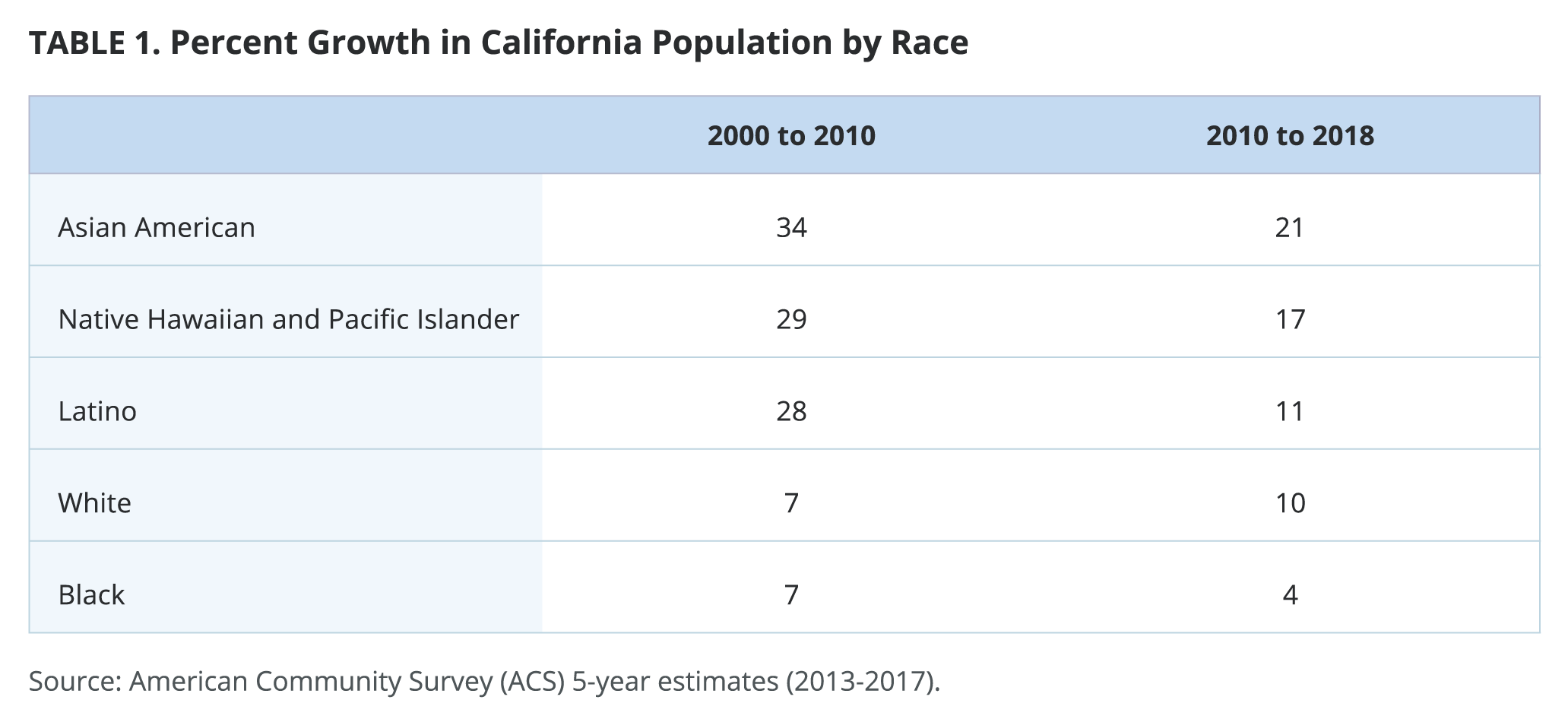
Between 2010 and 2017, most new immigrants to California came from Asia, while fewer than three in ten came from Latin America. Consequently, nearly three in four (74%) adult AAPIs in California are foreign-born, with Indians and Vietnamese representing the largest foreign-born populations and NHPI and Japanese representing the smallest. Nearly nine in ten Indians (87%) are foreign-born, followed by Vietnamese (81%), Koreans (79%), Chinese (77%), Filipinos (73%), Cambodians (69%), Hmong (52%), Japanese (40%), and NHPI (32%). In contrast, majorities of NHPI (68%), Japanese (61%), and nearly half of Hmong (48%) are native-born.
Among the AAPI adult population in California, about half (49%) are foreign-born naturalized citizens, while one in four are non-citizens (25%). Majorities of Vietnamese (67%), Filipinos (53%), Cambodians (52%), Chinese (51%), and half (50%) of Koreans are naturalized citizens. Smaller proportions of Indians (44%), Hmong (42%), NHPI (18%) and Japanese (15%) are also naturalized citizens. Indians represent the population with the highest percentage of non-citizens (43%), followed by Koreans (29%), Chinese (26%), Japanese (25%), and Filipinos (20%).
Among the Hmong population, four in ten were born in California (40%), while one-third (33%) were born in Laos.
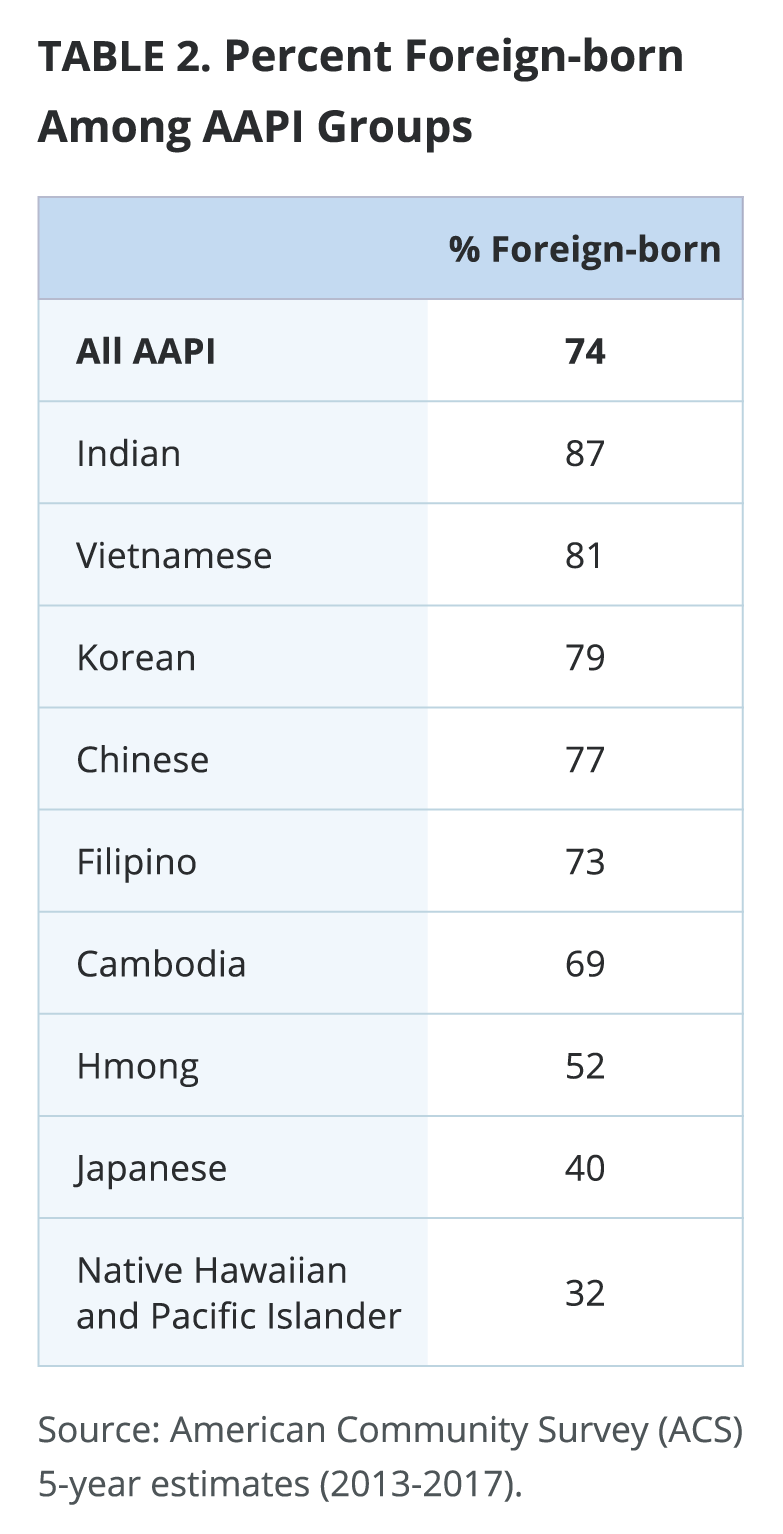
It is clear that more recent AAPI immigration is driven by labor recruitment, particularly high-skilled labor recruitment from India, China, Korea, and the Philippines. Limited migration from Vietnam, Laos, and Cambodia is mostly due to family-based migration linked to previous waves of refugees. Not surprisingly, among the AAPI foreign-born population, most were born in their corresponding countries.
The distinct historical trajectories of AAPI populations help to explain average socioeconomic differences between ethnic groups that have benefited from U.S. labor recruitment, especially the provision of high-skilled visas that select for highly educated immigrants (Chinese, Indian, South Korean, Japanese, and to some extent Filipinos) and ethnic groups that have come to the U.S. as refugees the result of conflict (Cambodians, Hmong, and Vietnamese) and U.S. colonialism (Native Hawaiians and Pacific Islanders).
A significant portion of AAPI Californians are highly educated with nearly half (46%) holding a college or post-graduate degree, compared to three in ten Californians (30%) with higher education. There are notable differences in education by ethnic group, however. Nearly seven in ten Indians (68%) either hold a college or a postgraduate degree, and Indian men (42%) are more likely to hold a postgraduate degree than Indian women (33%). In addition, majorities of Koreans (54%), Chinese (51%), and Japanese (50%) hold a college or a postgraduate degree. To compare, a little more than 30% of Californians overall hold a college degree or higher.
Fewer than one in five Cambodians (17%), Native Hawaiians and Pacific Islanders (16%), and Hmong (15%) hold a college or postgraduate degree. About half of each group have high school or less education (53%, 46%, and 51%, respectively).
At the same time, educational attainment among AAPIs is not highly correlated with English language proficiency. Limited English proficiency, when combined with lack of Asian language assistance, produces significant barriers for AAPIs in their interactions with various public and private institutions including schools, government agencies, and nonprofits.[3] Even though Chinese (40%) and Korean (36%) Americans in California rank relatively high among Asian groups with respect to bachelor’s degree attainment, nearly half in each group are unable to speak English very well. For other groups such as Vietnamese, Hmong, and Cambodian Americans, limited English proficiency compounds group disadvantages in socioeconomic status.
AAPIs tend to reside in specific California regions. Indian Americans and Chinese Americans are more heavily concentrated in the Bay Area, with 49% and 46% of each group’s adult population residing there. Korean and Cambodian Americans are most concentrated in Los Angeles County, accounting for 46% and 38% of each group’s statewide adult population. Groups like Vietnamese Americans have about evenly sized concentrations in Orange County and the Bay Area (primarily in the San Jose area), and Filipinos have similar high concentrations in the Bay Area and Los Angeles County. Most Hmong in California live in the Central Valley, which accounts for 83% of the group’s statewide population. Pacific Islanders and Japanese Americans tend to be spread more evenly across California’s major regions. Importantly, educational attainment also tends to correlate with region, as AAPIs in the San Joaquin Valley and Inland Empire tend to have lower levels of educational attainment than those living in the Bay Area, Los Angeles, and Orange County.
AAPI workers in California are overrepresented in occupations making under $20,000/year full-time as well as in occupations making over $100,000/year full-time.[4] AAPI workers in California are overrepresented in sales, office and administrative support positions, and in computers and mathematics occupations, which are typically higher-wage. They are also overrepresented in positions related to food preparation and services, and health care support, which tend to pay below-median wages.
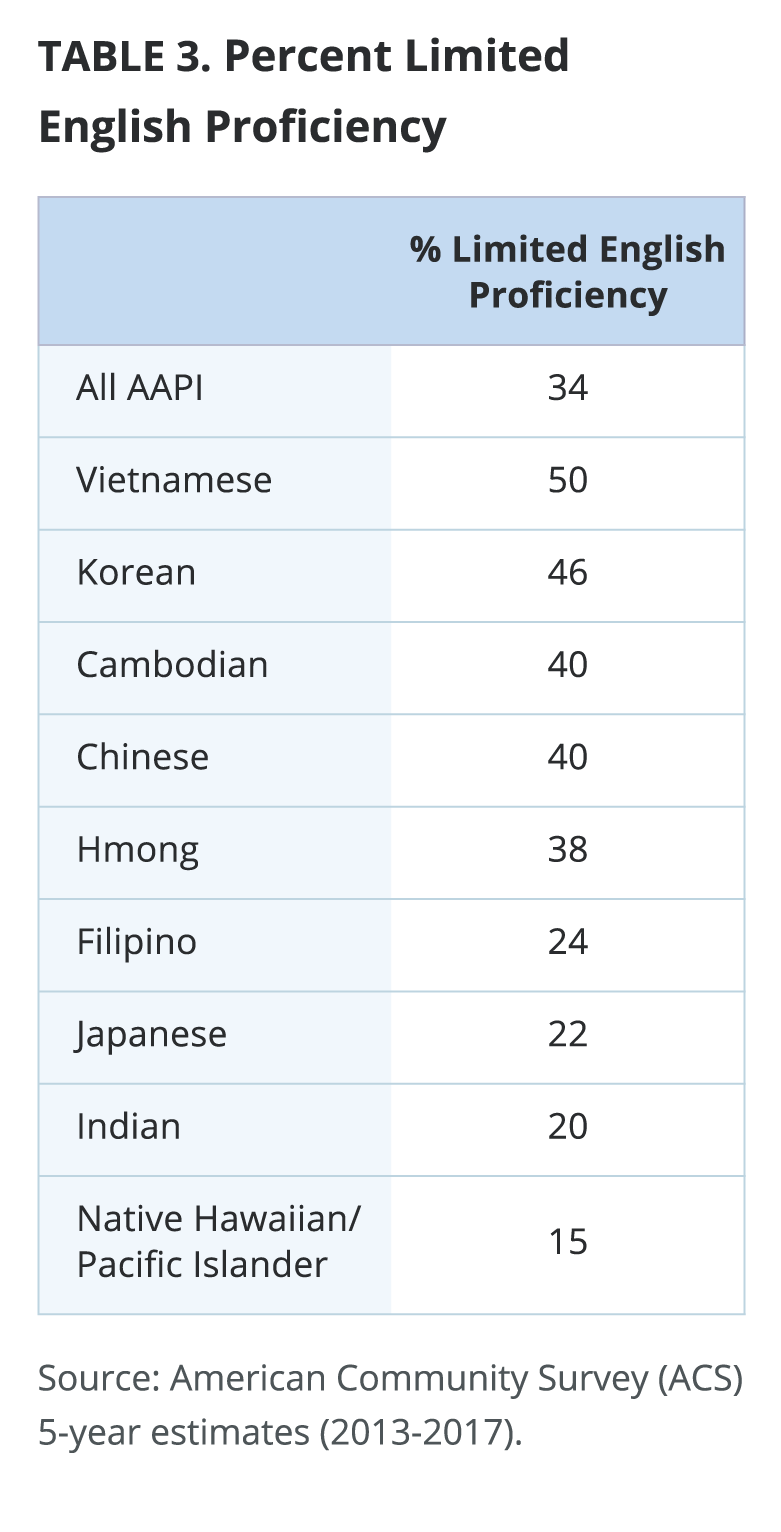
Political Profile of Asian American and Pacific Islanders in California
AAPI Californians vary by party affiliation and ideology. Most AAPI Californians identify with the Democratic party (54%), one-third with the Republican party (33%), and fewer than one in ten are Independent (9%). In terms of political ideology, nearly one-third of AAPI Californians identify as liberal (29%), one-quarter as conservative (24%) and more than four in ten AAPI Californians (42%) identify as moderate.
Among ethnic subgroups, majorities of Japanese (70%), Indian (65%), Korean (58%), Native Hawaiian and Pacific Islander (56%), Cambodian (54%), Hmong (54%), Chinese (53%), and Filipino (52%) Californians identify as Democrats. Vietnamese are the only group that appears to be evenly split by party affiliation. Nearly four in ten Vietnamese identify with the Democratic party (41%) and a similar proportion identify with the Republican party (37%). Fifteen percent of Vietnamese are independent.
Religious Profile of Asian American and Pacific Islanders in California
Half (50%) of AAPI Californians are Christian, including 22% who are Catholic, 10% who are mainline Protestant, 17% who are evangelical Protestant, and 1% who identify as some other type of Christian. Smaller proportions of AAPI Californians identify as Buddhist (12%), Hindu (6%), or another non-Christian religion (3%), while one in four (25%) are not affiliated with any religious group.
Work and AAPIs: Focus on AAPIs Workers Struggling with Poverty
AAPIs make up about one in six workers (16%) in California.[5] Missing from many accounts of the California workforce is attention to AAPI workers who are struggling with poverty.
Definition: Working and Struggling with Poverty
The 2019 AAPI California Workers Survey provides a portrait of the working lives of Asian American and Pacific Islander (AAPI) residents, via a survey of 2,684 respondents who live in California, with a focus on how their experiences differ by ethnicity, gender, age, educational status, and region, among other characteristics.
In this study, “working” AAPI Californians are defined as those who said they were currently employed full or part-time, those who are unemployed and on a temporary layoff from a job, or those who are unemployed but still seeking employment.
The report uses a poverty threshold for each respondent based on the Census Bureau’s Supplemental Poverty Measure to identify AAPI Californians who are “struggling with poverty.” Specifically, it uses the California Poverty Measure, which adjusts for geographic location within California. Californians living in households with an adjusted income that is 250% or less than their personal poverty threshold are classified as struggling with poverty. For example, if a household has a poverty threshold of $22,873 —the threshold of the median respondent in the survey—they would be classified as struggling with poverty if their adjusted income was $57,182 or less. This cutoff is designed to include not only those actively living in poverty at the time of the survey, but also to include those whose economic condition is precarious.
AAPI California respondents who meet these two conditions are classified as working and struggling with poverty in this report. Those who are working and whose adjusted income exceeds 250% of their poverty threshold are identified as working but not struggling with poverty.
AAPI Californians Who are Working and Struggling with Poverty
Among all Asian and Native Hawaiian and Pacific Islander (AAPI) Californians, nearly one in four (23%) are working and struggling with poverty, 37% are working but not struggling with poverty, and 40% are not working.[6] AAPI Californians are less likely than Californians overall to be working and struggling with poverty. Among all California adults in 2018, nearly one-third (31%) of all Californians are working and struggling with poverty, 36% are working but not struggling with poverty, and 32% are not working.
AAPI subgroups in California have strikingly different proportions who are working and struggling with poverty. Specifically, more than four in ten Hmong (44%) and 36% of Native Hawaiian and Pacific Islanders (NHPI) are working and struggling with poverty. Among other groups, about one in four or fewer are working and struggling with poverty: Cambodians (26%), Vietnamese (26%), Chinese (23%), Filipinos (22%), Japanese (22%), Indians (20%), and Koreans (15%).
For the largest AAPI subgroups, the proportion of those who are working and struggling with poverty does not vary significantly from the general profile of AAPIs in California. About 30% of the working and struggling group are Chinese, 24% are Filipino, 14% are Vietnamese, and 11% are Indian, roughly comparable to their share of residents (29%, 25%, 12%, and 13%, respectively). For example, Chinese make-up the largest group of AAPIs in the California population and the largest AAPI group in the working but struggling with poverty category. Those Chinese who are U.S.-born are more likely to fall into this category than those who are foreign-born. For the smaller AAPI subgroups, Hmong are twice as likely to be represented among those working and struggling with poverty as they are in the population.
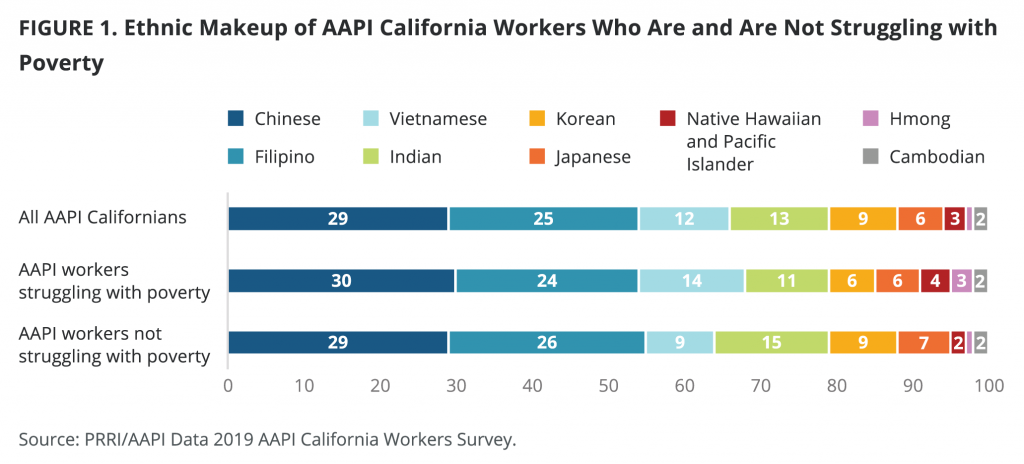
The proportion of AAPI Californians who are struggling with poverty is similar in Los Angeles (23%), the South Coast and Border (22%) (which includes 22% in Orange County and 20% in San Diego County), the Bay Area (20%), and Sacramento Valley (20%). These are areas of high housing costs, but also areas that tend to have higher-paying jobs and a larger mix of high-skill occupations. By contrast, a higher share of AAPIs in the San Joaquin Valley (50%) and Inland Empire (37%) are working and struggling with poverty. These regions have a higher share of jobs that pay low wages without benefits such as employer-provided health insurance.
The majority of AAPI California workers are foreign-born (66%). While nearly two-thirds (65%) of foreign-born AAPI workers are notably not struggling with poverty, more than one-third (35%) are, a rate significantly lower than the rate of AAPI Californian workers who are native-born (43%).
About six in ten (61%) AAPIs who are working and struggling with poverty are foreign-born, which includes 43% who are naturalized citizens, 10% who are green card holders, 3% who hold a visa, and 3% with some other arrangement. Nearly four in ten (39%) working and struggling AAPIs were born in the U.S. These statistics show that AAPIs working and struggling with poverty are not confined to recent immigrants but include more established immigrants and those who are U.S.-born, as well.
There are no significant differences by age between AAPI workers who are struggling with poverty and those who are not. About three in ten (31%) AAPI California struggling workers are 18 to 29 years old and another 46% are 30 to 49 years old. This profile is not significantly different, however, from the profile of workers who are not struggling with poverty (28% and 44%, respectively). AAPI workers 50 to 64 years old make up a smaller proportion (15%) of working struggling with poverty than the younger age groups.
AAPI workers tend to be highly educated. Most AAPI workers either hold a college (54%) or postgraduate degree (28%). Fewer than four in ten (37%) college-educated AAPI workers are struggling with poverty. Just under one in five (19%) AAPI workers with a postgraduate degree are struggling with poverty. The reverse is true for AAPI workers with a high school education or less: the vast majority (81%) are struggling with poverty.
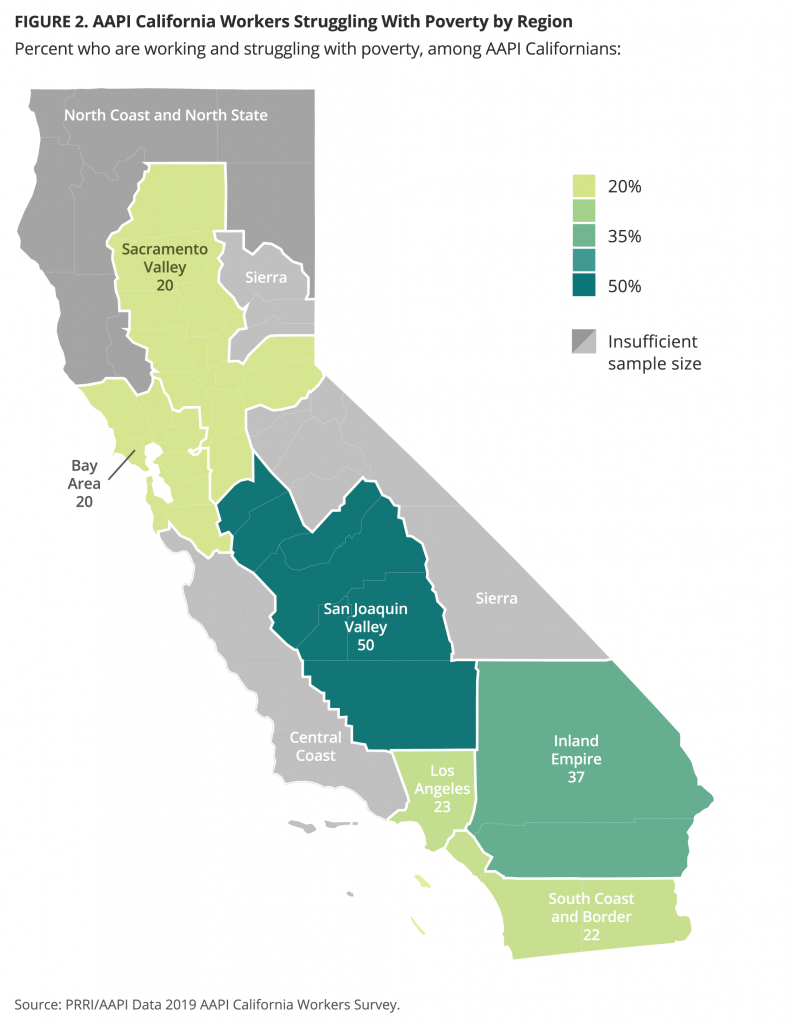
Views on Economic Opportunity, Efficacy, and Mobility
Belief in the American Dream
Asian American and Pacific Islander California residents, including those who are working but struggling with poverty, are notably more likely than all Californians to believe that the American Dream—the idea that if you work hard, you will get ahead—still holds true today. A majority of AAPI Californians (62%) believe the American Dream still holds true, compared to three in ten (30%) who say that the American Dream once held true but no longer does today. Only 6% of AAPI residents say the American Dream never held true. In contrast, less than half (47%) of Californians overall say the American Dream still holds true today, while 43% say it once held true but does not anymore, and one in ten (10%) say it never held true.
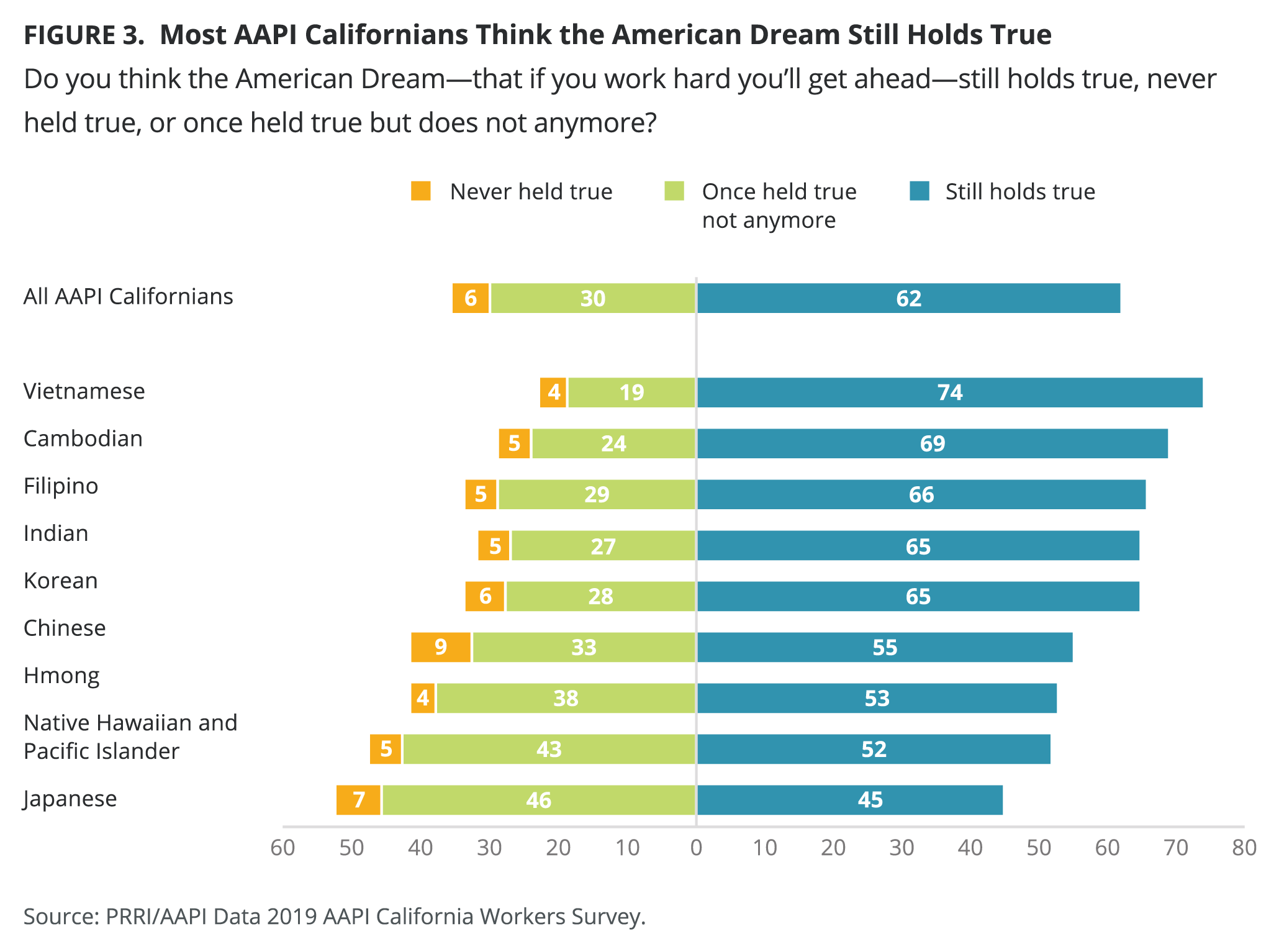
Majorities of both AAPI workers struggling with poverty and workers who are not struggling with poverty say that the American Dream still holds true today (56% for both). AAPI workers are less optimistic, however, than AAPI Californians who are not working, among whom 70% say the American Dream still holds true.
With the exception of Japanese Californians, majorities of all other ethnic subgroups say the American Dream still holds true today: Vietnamese (74%), Cambodians (69%), Filipinos (66%), Koreans (65%), Indians (65%), Chinese (55%), Hmong (53%), and NHPI (52%). Among Japanese Californians, opinions are divided over whether the American dreams still holds true today or whether it once held true but no longer does (45% vs. 46%). This pattern shows that those groups with a higher proportion of foreign-born members, are more likely to say the American Dream still holds true compared to those with fewer foreign-born members. With more U.S.-born members, belief in the American Dream seems to decline
Majorities of AAPI men (66%) and women (59%) say the American Dream still holds true today, as do majorities of AAPI Californians across all levels of education. Most AAPI Californians with a college or postgraduate degree (61%) as well as those without a college degree (64%) believe that the American Dream still holds true today. Senior AAPI Californians (77%) are especially more likely to say that the American Dream still holds true today, compared to other groups ages 18-29 years old (53%), 30-49 years old (55%), and 50-64 years old (63%).
Majorities of AAPI Californians who live in Sacramento Valley (76%), the San Joaquin Valley (67%), and the Inland Empire (67%) regions say the American Dream still holds true today, as do smaller majorities of AAPI Californian residents in the South Coast and Border (63%) region, in the Bay Area (62%), and in Los Angeles (55%), perhaps reflecting cost of living differences between the regions. Within the South Coast and Border region, residents of San Diego (64%) and Orange (63%) counties are equally likely to say that the American Dream still holds true today.
The California Dream
The survey also asked AAPI Californians about the California Dream, the idea that Californians are more likely to experience the rewards of their efforts in the state than elsewhere in the country. Fewer than one-third (31%) of AAPI Californians believe it is easier to achieve the American Dream in California, compared to nearly four in ten (39%) who believe that it is harder to achieve the American Dream in California than elsewhere in the U.S.; about one quarter (24%) of AAPI Californians think that their prospects are about the same in California as elsewhere. AAPI Californians are somewhat more optimistic than all residents statewide—a majority (55%) of all Californians say the American Dream is harder to achieve in California, about three in ten (29%) say it is about the same as elsewhere, and only 16% say it is easier to achieve in California.
AAPI California workers—whether struggling with poverty or more economically secure—are more pessimistic than all AAPI Californians about the California dream. Nearly half of both those who are struggling with poverty (47%) and those who are not struggling with poverty (48%) say that the American Dream is harder to achieve in California than elsewhere in the United States, compared to about three in ten of AAPI workers (30% struggling vs. 28% not struggling) who believe it is easier to achieve the California dream.
Among AAPI ethnic subgroups, NHPIs (58%) are particularly pessimistic, saying the American Dream is harder to achieve in California than elsewhere. A plurality of Filipino (44%), Japanese (44%), Chinese (39%), Cambodians (38%), and Hmong (36%) say the same. By contrast, about one-third of Indians (33%), Koreans (32%), and Vietnamese (30%) express the same view; pluralities of these groups say the American Dream is easier to achieve in California than elsewhere.
AAPI women (41%) are more likely than AAPI men (35%) to say the American Dream is harder to achieve in California than it is elsewhere in the U.S. Younger AAPI Californians, including those ages 18-29 years old (50%), 30-49 years old (48%), and 50-64 (43%), are more likely than seniors ages 65 and over (13%) to say the American Dream is harder to achieve in California than elsewhere. AAPI Californians with a college degree or higher (43%) are more also pessimistic than those without a college degree (27%) about achieving the American Dream in California.
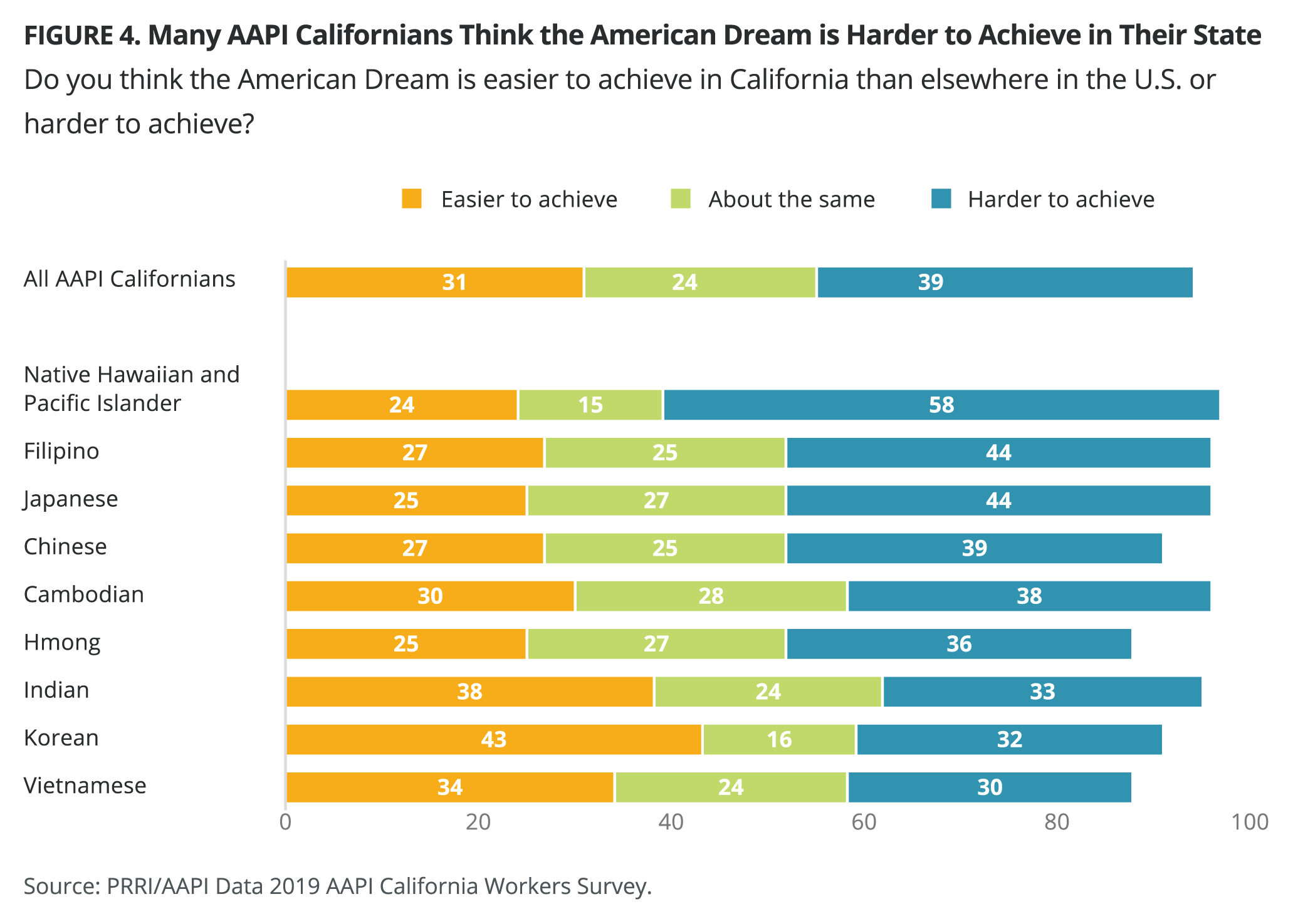
Personal Financial Situation
How Are You Doing Compared to Other Californians?
Asian American and Pacific Islander Californians are relatively optimistic about their personal financial status compared to other Californians. More than one-third (36%) of AAPI say they are doing better financially than most other people in California, while only half as many (17%) say they are doing worse. Almost half (45%) of AAPI Californians say they are doing about the same financially as other Californians. This positions AAPI as more likely than Californians overall to say they are doing better financially than other Californians (36% vs. 29%).
AAPI workers who are struggling with poverty are about half as likely as non-struggling workers to say they are better off than other Californians. Only one-fourth (25%) of struggling workers, compared to almost half (47%) of workers who are not struggling with poverty, believe they are better off than other Californians. Still about half (48%) of struggling AAPI workers say they are doing about as well as other Californians, while 27% of struggling workers say they are doing worse.
Significant proportions of most ethnic subgroups say they are better off than other Californians: Indians (50%), Koreans (44%), Cambodians (40%), Vietnamese (38%), Filipinos (37%), and NHPI (34%). Chinese (28%), Japanese (28%), and Hmong (21%) Californians are less likely to feel this way. Majorities of Hmong (57%) and Chinese (51%) and nearly half of Japanese (48%) say they are doing about the same as other Californians. This is somewhat surprising given that, on average, Chinese are much less likely than Hmong to be working and struggling with poverty and could reflect class-segregation among different AAPI groups, particularly with respect to the high concentration of Hmong in the Central Valley.
Across California’s regions, there are different views of personal financial situations among AAPIs when compared to most other Californians. More than half (51%) of San Joaquin Valley residents say they are doing better than other Californians, though only half as many (26%) Inland Empire residents agree. Meanwhile, Inland Empire residents are particularly likely to say they are doing about the same financially as other Californians (51%).
Economic Mobility
Geographic Mobility: Difficulty Finding better Jobs Due to Distance
More than four in ten (43%) AAPI Californians, including those struggling with poverty, say that one of the major obstacles to finding a well-paying or better job is that most jobs are too far away from where they live. A little over one in five AAPI Californians (22%) also believe they don’t know where to look to find good job announcements, and more than one in ten think they are either not fluent enough in English (13%) or it is difficult for them to fill out applications on the internet (12%) to find a well-paying or better job.
Among AAPI workers who are struggling with poverty, a majority (55%) say that most jobs are too far away from where they live, as do nearly half of AAPI workers who are not struggling with poverty (48%).
There are stark differences, however, by ethnic groups, gender, and age. Majorities of Filipinos (55%), Native Hawaiians and Pacific Islanders (52%), and Japanese (50%) believe that one of the major obstacles to finding a better job is how far away most jobs are from where they live four in ten Hmong (41%), Chinese (40%), and Indians (40%) agree. About three in ten Vietnamese (33%), Cambodians (30%), and Koreans (30%) express the same view. In addition, AAPI women (48%) as well as AAPI Californians under 50 years old (55%), are more likely to say that better jobs are too far away from where they reside, compared to AAPI men (34%) and AAPI seniors (20%) and AAPI ages 50 to 64 years old (39%).
AAPI Californians with a high school education are half as likely (23%) to hold this view than AAPI Californians with some college (43%), a college (49%), and postgraduate (45%) degree. Those who live in the Inland Empire region (56%) are more likely to say that one major obstacle to finding better jobs is the location of these jobs, compared to AAPI Californians who live in the San Joaquin Valley (37%).
Class Mobility: Then vs. Now
While most AAPI Californians describe themselves as coming from a middle, working or lower-class family, they tend to describe their current economic situation as rather unchanged from the one in which they grew up. Compared to their family’s financial position growing up, AAPI Californians are about equally likely to describe their current status as lower class (10% vs. 12% growing up), working class (25% vs. 28% growing up), middle class (48% vs. 45% growing up), and upper-middle or upper class (16% vs. 15% growing up).
Among AAPI California workers, those who are struggling with poverty show a slight shift downward in their economic status. Specifically, more than four in ten AAPI California workers who are struggling with poverty say they are working class today (42%), compared to one-third who say the same about their families growing up (33%). Additionally, slightly fewer workers describe themselves as middle class today (39%) than said they were middle class growing up (45%), though the difference is not significant. Struggling workers are about equally likely to describe themselves as lower class currently and growing up (13% vs. 15%).
In contrast, AAPI California workers who are not struggling with poverty show upward mobility. Compared to their description of their family’s economic status when they were a child, more than one in four AAPI California workers who are not struggling with poverty say that they are currently upper or upper middle class (26% vs. 17% growing up), while fewer than one in five (17%) say they are working or lower class, compared to 33% growing up.
With the exception of Cambodians, there are no major differences between each ethnic subgroup’s current economic status and their family’s economic status growing up. Cambodians are the only ethnic group that show signs of upward mobility. While a majority of Cambodians (58%) say they were working or lower class growing up, today this number is about four in ten (41%). Moreover, about four in ten Cambodians (41%) say they are middle class today, compared to 31% growing up.
AAPI California men show upward economic mobility, but women do not show any changes. AAPI California men are more likely to say they are upper-middle or upper class today (18%) than when they were growing up (13%) and are less likely to say they are working or lower class (34% vs. 41% growing up).
There are significant differences by education. AAPI Californians who hold a college or postgraduate degree are more likely to experience upward economic mobility than those without a college degree. A majority of AAPI California college graduates are more likely to say they are middle class today (54% vs. 48% growing up) and less likely to say they are working or lower class (25% vs. 35% growing up). In contrast, about six in ten AAPI California non-college graduates say they are working or lower class today (58%), compared to about half growing up (51%).
Young People Seeking Opportunities Elsewhere
AAPI Californians are evenly split in their opinions about economic opportunities for young people in their local communities. While nearly half (44%) of AAPI Californians say they would generally encourage young people in their local community to leave to find more opportunities elsewhere, a similar percentage (47%) say they would encourage young people to stay in their local communities. In contrast, most Californians are pessimistic about economic opportunities for young people in their local communities. Nearly two-thirds (64%) of all Californians say they would generally encourage young people in their community to leave in search of better economic opportunities.
When AAPI Californians were asked further about economic prospects for young people in California more generally (instead of local communities), AAPI Californians are more optimistic. A majority (56%) say that they would advise young people to stay in California in search of better economic opportunities, compared to only 37% who say the opposite.
The same patterns hold true for AAPI workers. Slim majorities of AAPI workers, whether they are struggling with poverty (51%) or not (52%), advise young people to leave their local communities in search for better economic opportunities. But when asked about California more generally, majorities of AAPI workers who are struggling (52%) and not (58%) advise young people to stay in the state to pursue better economic prospects.
Interestingly, with the exception of Filipinos, sizable proportions of other ethnic subgroups advise young people to stay in their local communities to find better opportunities. Majorities of Koreans (62%), Japanese (58%), Indians (56%), and Cambodians (51%) say young people should stay. More than four in ten Chinese (46%), Hmong (44%), and Vietnamese (44%) think young people should remain in their communities for better economic opportunities. In contrast, a majority of Filipinos (57%) believe that young people should leave their communities to pursue better opportunities.
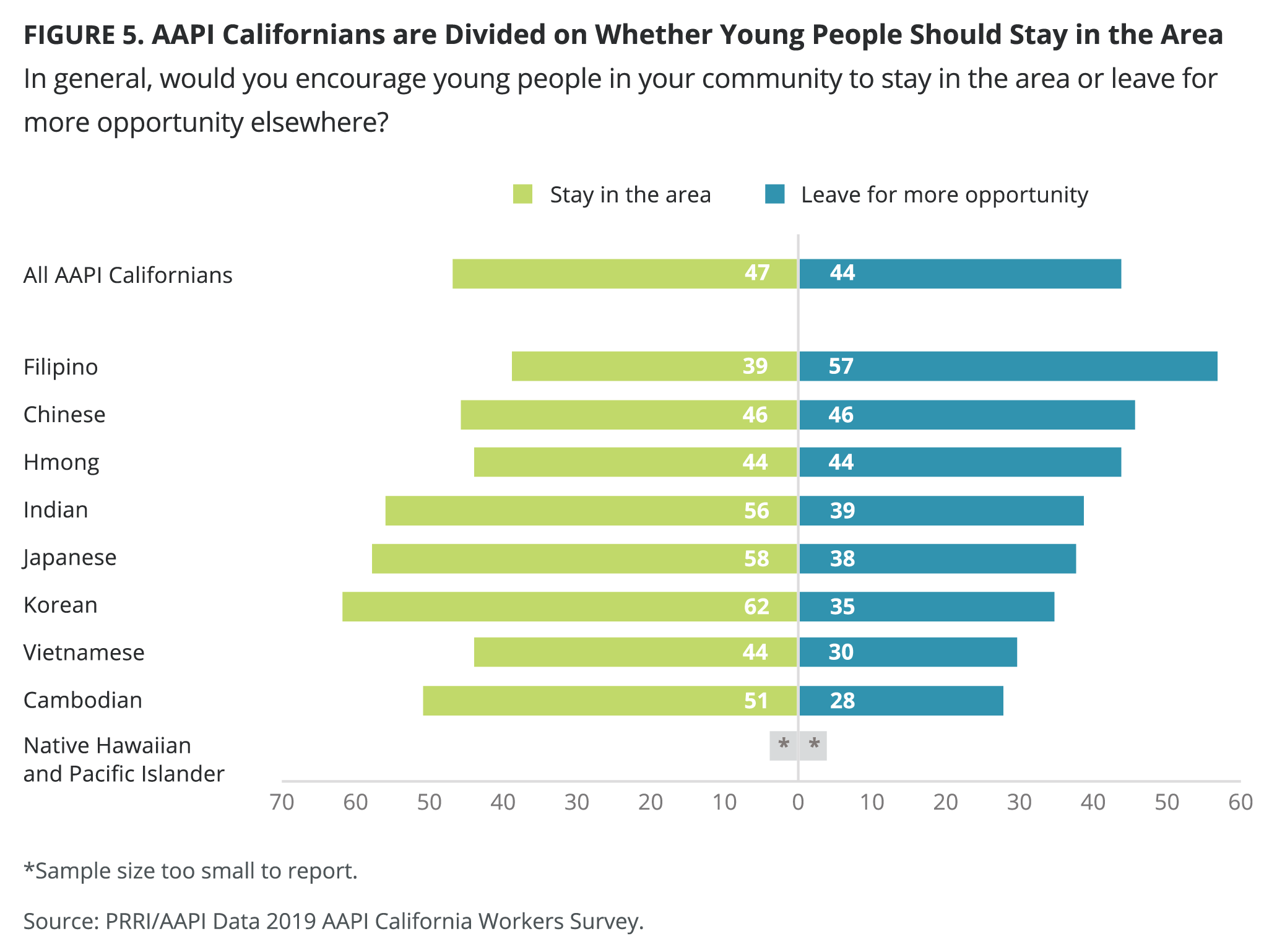
When thinking about opportunities in California, majorities of almost all ethnic subgroups think young people should stay in California to pursue better opportunities. The exceptions are Vietnamese (44%), who are less likely to think young people should stay in California.
More than four in ten foreign-born (49%) and U.S.-born (43%) AAPI Californians say that young people should stay in their local communities. There is a wider gap between foreign-born and U.S.-born AAPI when thinking about economic opportunities for young people in California more generally. A majority of AAPI foreign-born Californians (59%) say that young people should stay in California, compared to 48% of U.S.-born AAPI Californians.
There are also notable differences by age. AAPI Californians ages 18-29 (52%) and 65 and over (57%) are more likely to advise young people to stay in their local communities to seek economic opportunities, compared to smaller proportions of AAPI Californians ages 30-49 years old (46%) and 50-64 years old (36%) who express the same view. Interestingly, there are no education gaps.
Personal Efficacy
Hard Work and Determination Do Not Guarantee Success
AAPI Californians tend to reject the idea that hard work and determination are a guarantee of success for most people. A majority (55%) of AAPI Californians say that hard work and determination alone provide no guarantee of success for most people, while about four in ten (41%) disagree. These views closely mirror those of all Californians (54% vs. 44%, respectively).
About two-thirds of AAPI Californians (64%) working and struggling with poverty, compared to a smaller majority (54%) of AAPI workers who are not struggling with poverty, say that hard work and determination do not promise success for most people.
Majorities of Chinese (64%), Japanese (58%), NHPI (56%), Indians (55%), Hmong (54%), and Koreans (53%) agree that hard work and determination do not guarantee success. More than four in ten Filipinos (47%), Vietnamese (45%), and Cambodians (44%) also believe that hard work and determination do not guarantee success.
Moreover, half of all foreign-born AAPI Californians (50%) say that hard work and determination alone provide no guarantee of success for most people, compared to 65% of U.S.-born AAPI Californians.
AAPI Californians living in the Bay Area (57%) are notably more likely to agree that hard work and determination are not a guarantee of success, compared to AAPI California residents of the South Coast and Border region (45%)—which includes 48% in Orange County and 45% in San Diego County.
Changing Financial and Workplace Conditions
AAPI Californians are evenly divided whether it is possible to change one’s financial situation. Nearly half of AAPI Californians (47%) agree with the idea that at some point there is little a person can do to change their financial situation, while about the same percentage (47%) disagree with this statement. By comparison, more than half of Californians (56%) reject the idea that at some point there is little a person can do to change their financial situation, while about four in ten (42%) agree with this statement.
Nearly six in ten (58%) AAPI workers who are struggling with poverty say that there is not much a person can do to change their economic situation, compared to 42% of AAPI Californians who are working but not struggling with poverty.
There are no major differences by gender, age, education, or nativity. However, there are notable differences by ethnic groups. Majorities of Koreans (57%) and Chinese (55%), as well as almost half of Indians (49%), Native Hawaiian and Pacific Islanders (49%), and Japanese (47%), agree that there is not much a person can do to change their economic situation, compared to about four in ten Hmong (43%), Vietnamese (42%), Filipinos (37%), and Cambodians (35%).
There are also differences by region. AAPI Californians who live in the Inland Empire region (58%) and Los Angeles (52%) are more pessimistic about changing financial conditions, compared to only three in ten (30%) AAPI Californians living in the San Joaquin Valley who say there is not much a person can do to change their economic situation.
The Value of Education
Investment in College
Like Californians generally, most AAPI Californians believe in the promise of higher education. Nearly eight in ten AAPI Californians (76%) believe that a college education is a smart investment in the future, while about two in ten (22%) believe it is a gamble that may not pay off in the end. By comparison, among all Californians, the gap between those who believe and those who don’t in the promise of higher education narrows. A smaller majority of Californians (62%) believe that a college education is a smart investment in the future, while fewer than four in ten (37%) believe it is a gamble. Given that a high proportion of AAPIs arrive in the U.S. with a college degree or higher, it is not surprising that many believe that higher education is a good investment.
AAPI California workers who are struggling with poverty (67%) are notably less likely to say that a college education is a smart investment, compared to those who are not struggling with poverty (76%). Yet, majorities of both AAPI workers who are and are not struggling agree that a college education is a smart investment as opposed to a gamble that may not pay off in the end.
There are also notable differences across ethnic groups. Three in four or more of several ethnic groups agree with the promise of higher education, including Indians (81%), Chinese (79%), Koreans (79%), Vietnamese (77%), and Filipinos (75%). Smaller majorities of Cambodians (68%), Japanese (61%), Hmong (59%), and Native Hawaiian and Pacific Islanders (54%) agree.
Though most AAPI Californians across all age groups also believe in the promise of higher education, young AAPI Californians are less likely than seniors to say that attending college is a wise investment, (70% vs. 89%). Fewer than one in ten AAPI California seniors (6%) think that investing in higher education is a gamble that may not pay off in the end, compared to three in ten (30%) young AAPI Californians (ages 18-29).
Interestingly, despite belief in the value of higher education among most AAPI college graduates, AAPI college graduates (22%) are notably more likely than AAPI with a high school degree or less (14%) to express that investing in higher education is a gamble that may not pay off in the end.
There are also regional differences on this issue, even though most AAPI California residents believe in the promise of higher education. AAPI Californians living in the Bay Area (81%) are more optimistic about the value of education than those living in Los Angeles (73%) and the South Coast and Border regions (70%). In the South Coast region, residents of Orange (74%) and San Diego (64%) counties do not notably differ in their likelihood to say a college education is a smart investment in the future.
Family Expectations
Most AAPI Californians report growing up in a family where the expectation was to go to a four-year college (71%). This reflects the generally high levels of education that characterize immigrants from Asia as a result of selective immigration policies. Less than one in ten say they were expected to go to a community college (6%) or expected to either enroll in a vocational program (3%) or get a job (8%) immediately. Less than one in ten (9%) say that their family did not talk about these things. In contrast, about four in ten Californians overall report growing up in a family where the expectation was to go to four-year college (44%) and a little over one in ten say they were expected to go to a community college (11%). Moreover, about one-quarter say they were expected to either enroll in a vocational program (6%) or immediately get a job (17%). More than one in five (22%) say that their family did not talk about these things.
Workers who are struggling with poverty report having somewhat different familial expectations when they were growing up than workers who are not struggling. Compared to workers who are not struggling with poverty, struggling AAPI workers are less likely to say that they were expected to go to a four-year college (64% vs. 83%). Although a small proportion of struggling workers report that they were expected to immediately get a job (10%) or that this was something their family didn’t talk about (10%). Struggling workers are more likely to report that their family expected them to immediately get a job than AAPI workers who are not struggling with poverty (4%).
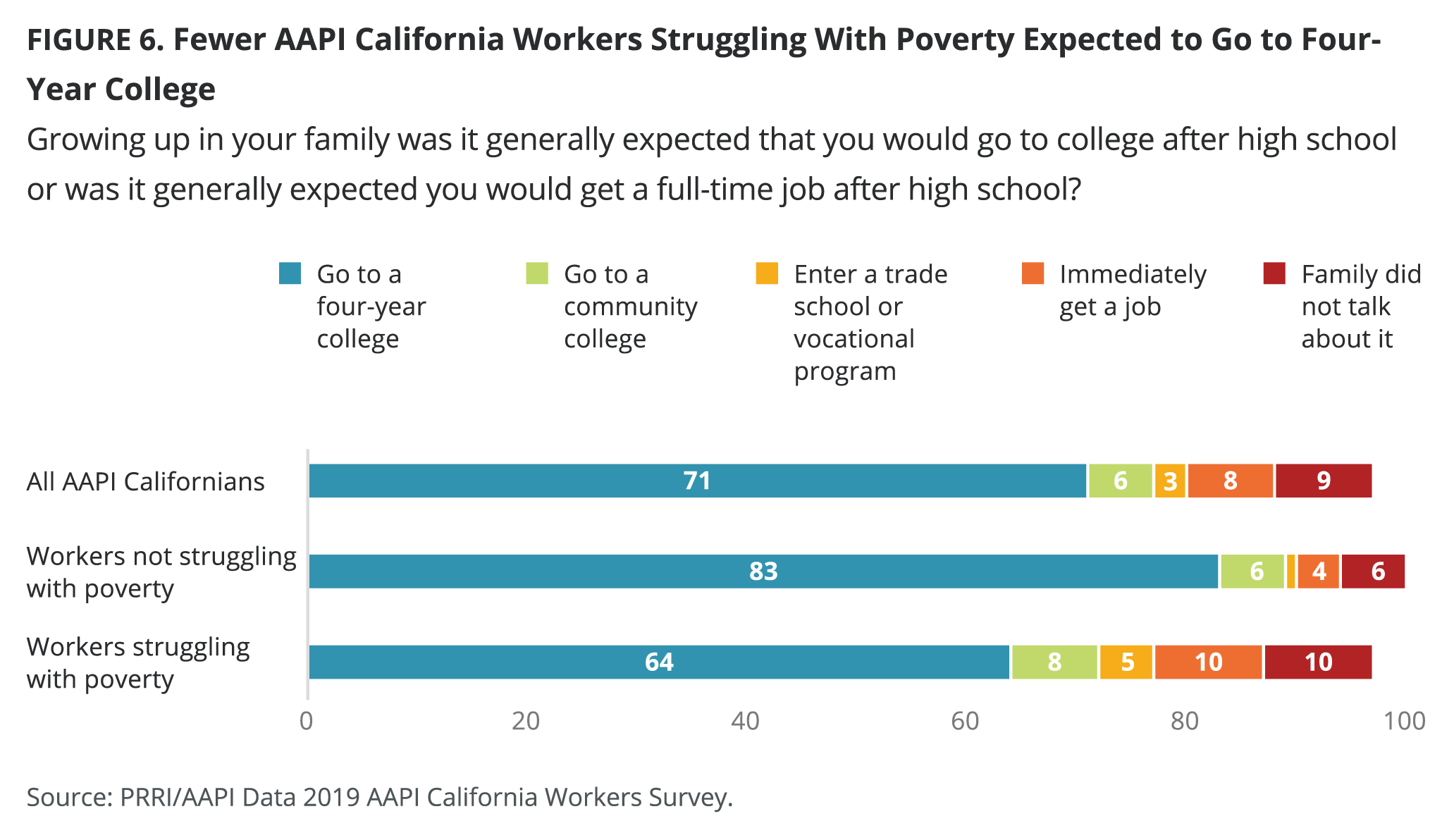
Koreans (79%), Filipinos (75%), Chinese (72%), and Indians (71%) are more likely to say that they grew up in a family where the expectation was to go to a four-year college than other ethnicities. Native Hawaiian and Pacific Islanders (22%), Cambodians (18%), and Hmong (14%) are more likely to say that their family expected them to get a job immediately, while more than one in ten Vietnamese (15%), Japanese (14%), Cambodians (12%), NHPI (12%), and Chinese (11%) say their family didn’t talk about these things. Note that those groups that have largely arrived in the U.S. as the result of high-skilled labor recruitment (Indians, Chinese, Koreans) are more likely to report family expectations to attend a four-year college than those groups whose histories in the U.S. are in large part the result of war, refugee resettlement, and U.S. colonial relations (Vietnamese, Hmong, Cambodians, NHPIs).
There are stark differences by education. Not surprisingly, more than eight in ten (83%) AAPI Californians with a four-year college degree and a postgraduate degree report that their family expected them to go on to a four-year college after high school. In contrast, among AAPI Californians without a four-year college education, only 39% report similar familial expectations.
Young AAPI Californians are more likely to report an expectation that they go to a four-year college than senior AAPI Californians. Three in four (75%) AAPI Californians ages 18-29 say their family expected them to attend a four-year college, while 61% of seniors ages 65 and over report the same.
There are also differences by region. More than seven in ten Los Angeles (76%), Bay Area residents (71%), and the South Coast and Border (71%), which includes residents of Orange County (71%) and San Diego (71%), say they were expected to go to a four-year college, compared to 63% of those in the Sacramento Valley and just under half (49%) in the San Joaquin Valley.
The Working Lives of Californians
On the Clock: How Many Hours are Californians Working?
When asked about how many hours they work in a typical week at their current or most recent job, about four in ten (38%) AAPIs in California say they work fewer than 40 hours in a typical week, while an equal number (38%) say they work a standard 40-hour week. About one-quarter (23%) report working more than 40 hours per week, including 17% who say they work 50 hours or more. AAPI Californians are more likely than Californians as a whole (30%) to report working fewer than 40 hours in a typical week.
AAPI struggling workers are about twice as likely as non-struggling AAPI workers to work fewer than 40 hours in a typical work week (44% vs. 21%). Struggling workers are also less likely than those working and not struggling with poverty to report working 40 hours in a typical week (38% vs. 50%) or working more than 40 hours (18% vs. 27%).
AAPI women are significantly more likely than AAPI men to work fewer than 40 hours (43% vs. 30%). AAPI Californians with lower levels of education are more likely to work fewer than 40 hours, with six in ten (61%) of high school graduates or less reporting this compared to 33% of college graduates and 23% of postgraduates.
There are also notable variations surrounding the typical work week among AAPIs, particularly regarding who works less than 40 hours per week. A slim majority (53%) of Koreans and half (50%) of Hmong say they work fewer than 40 hours. Four in ten or fewer Vietnamese (40%), Chinese (39%), Cambodian (35%), Filipino (35%), Indian (30%), Native Hawaiian and Pacific Islanders (30%) work fewer than 40 hours while one-quarter (24%) of Japanese say the same. Native-born AAPI Californians are less likely than foreign-born Californians to report working fewer than 40 hours (32% vs. 39%).
Challenges Faced in Working Life
Work Flexibility
The difficulty of Taking Off Work for Personal Matters
Most Asian American and Pacific Islander Californians report that they have flexibility at work if they needed to take time off to take care of personal matters. About three in ten (28%) AAPIs say it would be somewhat or very difficult to take time off work to address personal or family matters. Seven in ten (72%) say it would not be too difficult or at all difficult to take a day or two off work to take care of personal or family matters. Californians overall are less likely to report difficulty taking time off (23%).
AAPI struggling workers (43%) are twice as likely as more economically secure workers (20%) to say it would be somewhat or very difficult to take time off work to deal with personal or family matters.
There are notable differences among AAPI Californians in their ability to easily take time off based on nativity and ethnicity. U.S.-born workers are much more likely to say they would face some difficulty taking time off work (39%) than those born outside of the United States (22%). About four in ten Native Hawaiian and Pacific Islanders (45%) and Indians (39%) say they would have difficulty taking time off work as do about one-third of Hmong (36%), Japanese (33%), Cambodian (31%), Vietnamese (31%), and Korean (28%) Californians. Just under one in four Filipinos (24%) and Chinese (22%) also report that they would experience difficulty taking time off work.
Not surprisingly, workers who are paid hourly rates (35%) are more likely than salaried employees (23%) to say it would be difficult to take time off work.
Ability to Take Vacation
Two-thirds (67%) of Asian American and Pacific Islander Californians say that they or someone in their household took a vacation that lasted more than three days in the last year, while about three in ten (31%) say that they did not. AAPI Californians are more likely than Californians overall (60%) to have taken a vacation in the past year.
Workers who are struggling with poverty are significantly less likely than those who are not struggling to have taken a vacation that lasted more than three days in the last year (61% vs. 82%). The likelihood of taking a vacation increases with higher levels of education. More than eight in ten AAPI Californians with a postgraduate degree (81%) say they have taken a vacation, compared to seven in ten (70%) of those with a college degree, 58% with some college experience, and just under half (47%) of those with a high school degree or less.
There are substantial divides by ethnicity on whether AAPI Californians took vacations in the last year. About eight in ten (79%) Indians and seven in ten Filipino (71%) and Chinese (70%) Californians say that they or someone in their household took a vacation lasting more than three days in the last year. Smaller majorities of Korean (64%), Native Hawaiian and Pacific Islander (59%), Japanese (59%), and Vietnamese (56%) Californians reported the same. Less than half of Cambodians (45%) and Hmong (41%) say they took three days or more of vacation in the last year.
Job Security
Employees Feel Replaceable
More than six in ten (63%) AAPI Californians say that employers generally see people like them as replaceable, while three in ten (30%) disagree. AAPI Californians are slightly less likely to hold this view than Californians overall (67%).
Workers who are struggling with poverty (70%) are roughly as likely as more financially secure workers (64%) to say that employers generally see people like them as replaceable.
There are also notable differences by both nativity and ethnicity. More than seven in ten (72%) U.S.-born AAPI Californians feel that employers think of them as replaceable at work, while six in ten (59%) of those born outside the United States agree. Additionally, Japanese (71%), Chinese (70%), and Native Hawaiian and Pacific Islander (68%) Californians are particularly likely to feel dispensable at work, as do smaller majorities of Filipinos (63%), Hmong (62%), Indians (60%), and Koreans (58%). About half of Cambodian (50%) and Vietnamese (47%) Californians also say that employers generally see people like them as replaceable.
Workplace Injury
Just over one in ten (11%) Asian American and Pacific Islander Californians report that they or someone in their household has been injured on the job, making them slightly less likely to be injured than Californians overall (15%). This pattern is partly a function of AAPIs being less likely to be working and struggling with poverty overall than other Californians. Injuries occur with much higher frequency among workers struggling with poverty (23%) than non-struggling workers (10%).
Interestingly, higher reporting of workplace injuries correlates inversely with age. AAPI Californians, ages 18-29 are much more likely to say they or someone in their household has been injured on the job (18%) than AAPI seniors ages 65 and over (2%).
Among AAPI ethnic subgroups, Native Hawaiians and Pacific Islanders (26%) and Hmong (19%) stand out as particularly likely to report that they or someone in their household were injured on the job. More than one in ten Filipino (16%), Indian (13%), and Japanese (12%) Californians report the same. Just under one in ten Vietnamese (9%), Cambodians (8%), Chinese (7%), and Koreans (7%) also say they or someone in their household was injured on the job.
Concerns About Losing Jobs Because of Automation and Technology
About three in ten (31%) AAPI Californians report that they are somewhat or very worried that they or someone in their family will lose their job because of advances in technology or automation, while about seven in ten (68%) say they are not too worried or not at all worried about this possibility. AAPI Californians closely resemble Californians overall in their likelihood to hold this concern.
Among working AAPI Californians, those who are struggling with poverty (51%) are about twice as likely as workers who are not struggling (28%) to express concern about the threat of automation to jobs.
Among AAPI ethnic subgroups, Hmong Californians (47%) stand out as much more likely than AAPI Californians overall to feel concerned about losing their job due to automation and technology. This is consistent with many of the findings from the survey showing that Hmong Californians are one of the most vulnerable AAPI groups when it comes to working and struggling with poverty. More than one-third of Indians (37%) and Native Hawaiians and Pacific Islanders (35%) are concerned about losing their job due to technology, as are about three in ten Chinese (32%), Vietnamese (31%), Japanese (29%), Filipino (28%), Korean (28%), and Cambodian (25%) Californians. Additionally, U.S.-born residents are much more likely than foreign-born residents to express this worry (40% vs. 28%).
Job Quality
Wage Theft
More than one in ten (15%) AAPI Californians report that they or someone in their household were required to work overtime without being paid for it. Just under one in ten report being paid less than the minimum wage (8%) or having their wages withheld by their employer without cause (7%). Combined, 20% of AAPI Californians report experiencing at least one of these forms of wage theft in the last year. AAPI Californians closely mirror Californians overall in their experiences with wage theft.
Overall, workers who are struggling with poverty are much more likely than more financially secure workers to report experiencing some form of wage theft. Struggling workers are more likely than non-struggling workers to have been required to work overtime without being paid for it (25% vs. 16%), paid less than the minimum wage (20% vs. 5%), or had their wages withheld by their employer (14% vs. 5%). Combined, 35% of AAPI Californians who are working and struggling with poverty report experiencing at least one of these forms of wage theft in the last year, compared to 19% of non-struggling workers. AAPI workers struggling with poverty are more likely to report being required to work overtime without pay and being paid less than minimum wage than California workers. This may be a function of immigrant exploitation, since AAPI workers are more likely to be immigrants than California workers more generally.
While most regions in California resemble the overall trends seen with wage theft, residents of San Joaquin Valley stand out as more likely to report incidents of wage theft. San Joaquin Valley residents are more likely to have been required to work overtime without being paid for it (30%), had their wages withheld without cause (30%), and been paid less than the minimum wage (21%).
Workplace Discrimination
Almost one in five (17%) Asian American and Pacific Islander Californians report that they or someone in their household experienced some form of racial discrimination in the workplace, while about one in ten (11%) say they have dealt with gender discrimination or sexual harassment. AAPI Californians are more likely to report dealing with racial discrimination than Californians overall (12%), but similarly likely to report experiencing gender discrimination (11%) or sexual harassment (8%) in the workplace.[7]
Incidences of discrimination are regrettably common among struggling workers. Almost three in ten (29%) AAPI workers struggling with poverty say they have experienced racial discrimination in the workplace compared to 16% of more financially secure workers. Similarly, AAPI struggling workers are more likely to report experiencing gender discrimination or sexual harassment than non-struggling workers (21% vs. 14%), though the gap is not quite as large.
Women and men are about equally likely to say that they or someone in their household have experienced racial (17% vs. 18%) and gender discrimination or sexual harassment (12% for both).
While most AAPI ethnic subgroups are similarly likely to experience racial discrimination as AAPI Californians overall, there are some significant differences. About one in four Native Hawaiian and Pacific Islander (29%) and Indian (24%) Californians have had such experiences. One in ten or more Hmong (19%), Chinese (16%), Filipinos (16%), Japanese (16%), Cambodians (14%), Vietnamese (14%), and Koreans (10%) also report experiencing racial discrimination.
As with reports of wage theft, AAPI residents of San Joaquin Valley are particularly likely to say they experienced racial (40%) and gender discrimination or sexual harassment (29%), while residents of Inland Empire are also more likely to report gender discrimination (18%).
The Cumulative Impact of Negative Workplace Experiences
Cumulatively, four in ten (40%) AAPI Californians report that they or a member of the household have experienced at least one of these negative workplace experiences in the past year. About three in ten (31%) say they have experienced between one and three of these incidents, while about one in ten (9%) say they have dealt with four or more in the last year. AAPI Californians are less likely to have had any of these negative workplace experiences than Californians overall (46%).
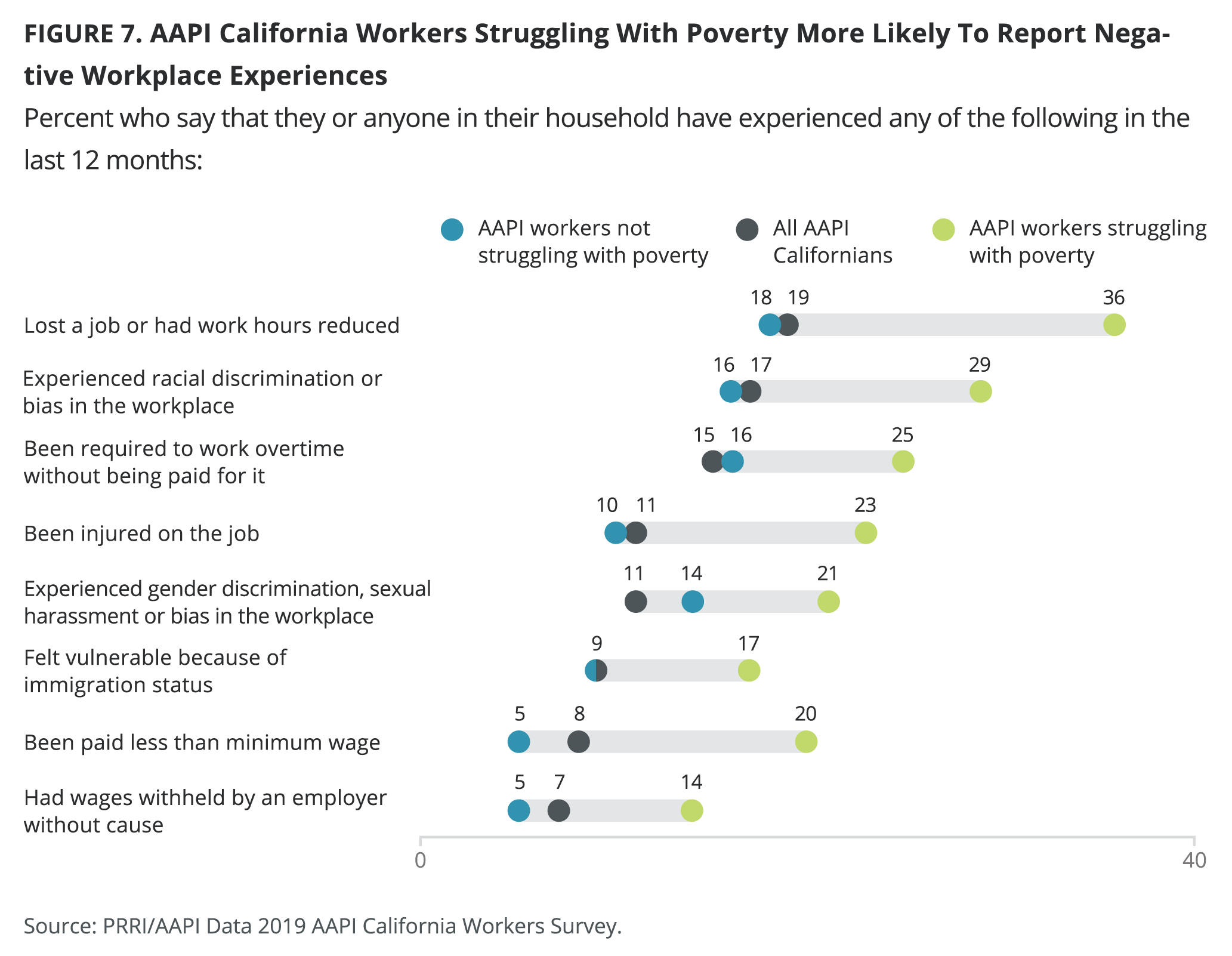
AAPI Workers struggling with poverty (59%) are far more likely than workers who are not struggling (42%) to have had at least one negative workplace experience. Almost one in five (19%) AAPI struggling workers have experienced at least four of these types of negative incidents while 8% of non-struggling workers report the same.
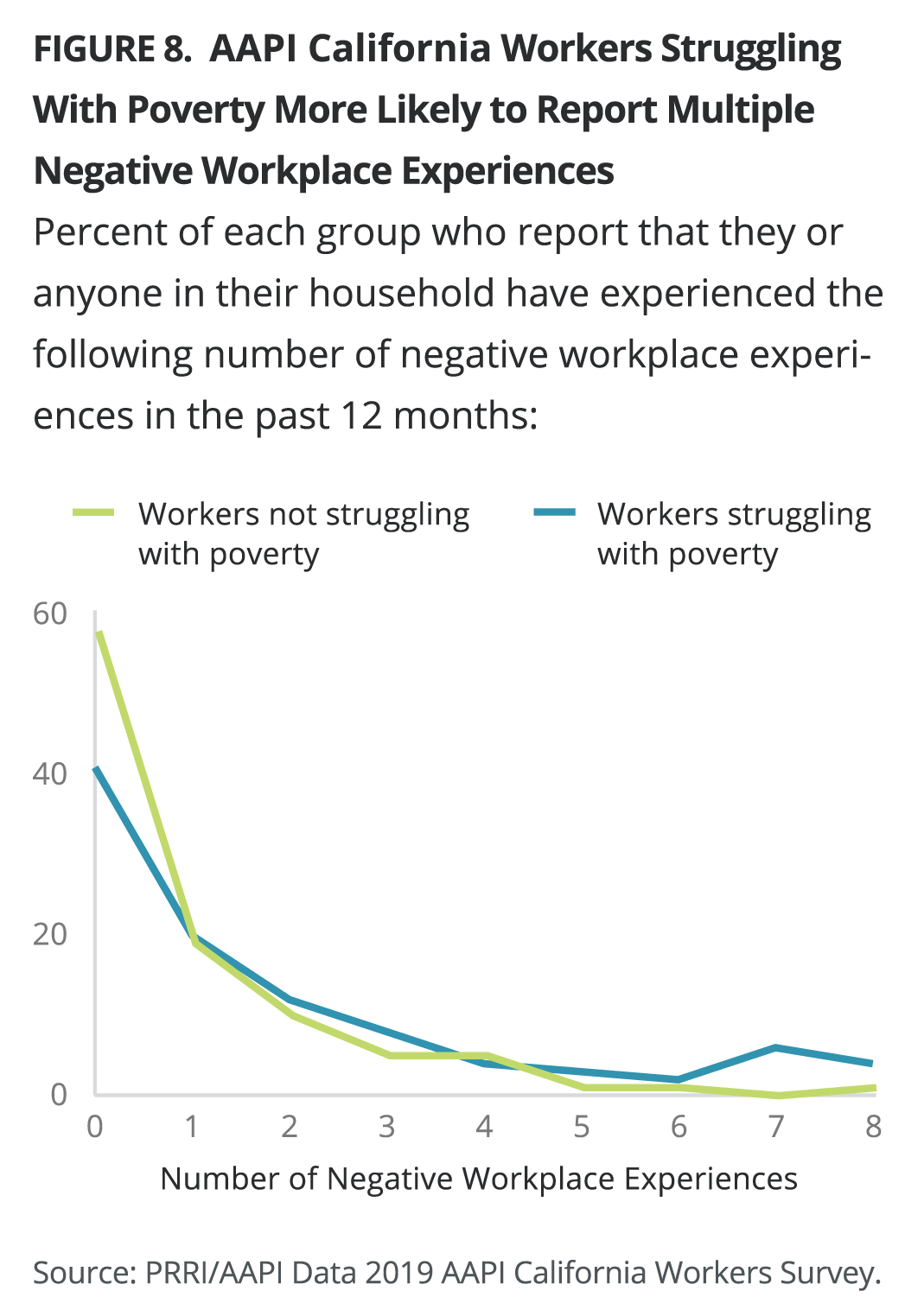
Among AAPI ethnic subgroups, Native Hawaiian and Pacific Islanders (62%) are particularly likely to have experienced at least one of these negative workplace experiences. A majority (52%) of Hmong also report experiencing at least one of these negative experiences, as do substantial portions of Filipino (45%), Indian (44%), Japanese (39%), Chinese (38%), Vietnamese (36%), Cambodian (32%), and Korean (26%) Californians. One-quarter (24%) of NHPI say they have endured at least four of these negative experiences.
Though most regions in California mirror California as a whole, San Joaquin Valley residents stand out as much more likely to say they had at least one of these negative experiences (67%), while Sacramento Valley residents are much less likely to have had one of these experiences (32%) though the proportion is still sizeable.
AAPI Californians ages 18-29 are more likely than AAPI seniors ages 65 and over to have had at least one of these negative experiences (56% vs. 16%).
The Gig Economy
Fourteen percent of Asian American and Pacific Islander Californians, compared to 11% of Californians overall, report participating in the gig economy, defined as being paid for performing miscellaneous tasks or providing services for others, such as shopping, delivering household items, assisting with childcare, or driving for a ride-hailing app.[8]
Many participants in the gig economy are also working full-time/part-time jobs. One in four (25%) AAPIs who work a part-time job say they work in the gig economy, while more than one in ten (14%) full-time workers say the same.
AAPI struggling workers are more likely to participate in the gig economy than non-struggling workers (24% vs. 15%). However, workers in the gig economy are equally likely to be struggling (50%) and non-struggling (50%) workers.
Younger AAPI Californians (ages 18-29) report higher rates of participation in the gig economy. About one in four (23%) young AAPI say they have had a gig economy job in the last year compared to few AAPI seniors ages 65 and over (5%).
Native-born AAPI Californians are almost three times as likely as foreign-born residents to work in the gig economy (26% vs. 10%). Among AAPI ethnic subgroups, Native Hawaiian and Pacific Islanders (30%) are more than twice as likely as AAPI Californians overall to participate in the gig economy. About one in five Cambodians (22%) and Indians (18%) also work in the gig economy, while around one in ten Vietnamese (14%), Chinese (13%), Filipino (13%), Hmong (13%), Japanese (11%), and Korean (9%) Californians report the same.
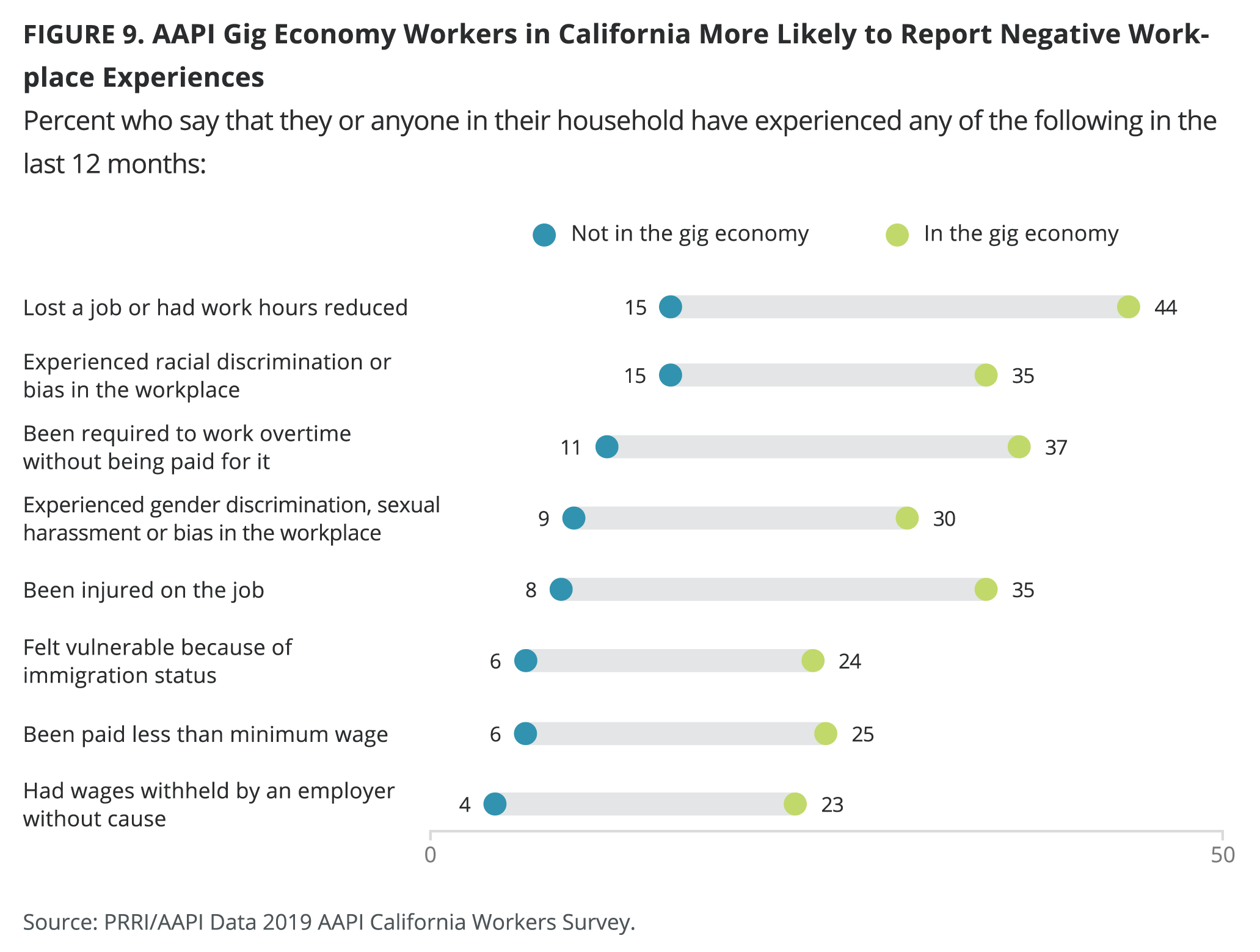
AAPI residents of San Joaquin Valley (36%) are much more likely than residents of any other region to participate in the gig economy.
AAPI Californians who participate in the gig economy are much more likely than non-gig economy workers to report various forms of wage theft, including being required to work overtime without compensation (37% vs. 11%), been paid less than the minimum wage (25% vs. 6%), or having their wages withheld without cause in the last year (23% vs. 4%). AAPI Californians who participate in the gig economy are also more likely than non-gig economy workers to report that they or someone in their household has lost their jobs or had their hours reduced in the last year (44% vs. 15%).
Gig economy participants are also more likely than non-participants to report experiences of discrimination in the workplace. Around one-third of gig economy participants report they or someone in their household have experienced racial discrimination (35%) or gender discrimination and sexual harassment (30%) in the workplace in the last year, compared to about one in ten (15% and 9%, respectively) AAPI Californians who are not gig economy participants. Those participating in the gig economy are also much more likely than those outside the gig economy to report that they or someone in their household has experienced a workplace injury (35% vs. 8%).
It is unknown whether these negative workplace experiences occur in gig work or in other jobs that AAPI Californians might have. People who have endured negative workplace experiences might be more likely to turn to the gig economy as an alternative, or these experiences could result from both workplaces and gig economy work.
Economic Distress
The survey included a robust array of questions aimed at understanding the economic experiences of AAPI Californians, including those who are working and struggling with poverty, and providing a more complete picture of the difficulties, challenges, and obligations that are part of their daily lives.
Respondents were asked if they or someone in their household had personally done or experienced any of the following in the last 12 months:
- Put off seeing a doctor or purchasing medication for financial reasons;
- Was not able to pay a monthly bill;
- Received food stamps;
- Reduced meals or cut back on food to save money;
- Received unemployment benefits;
- Received food from a food bank or pantry;
- Used a payday lending service;
- Helped parents or in-laws financially;
- Received financial help from friends or family; and
- Had difficulty paying rent or mortgage.
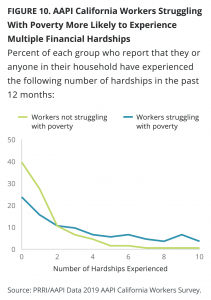
More than six in ten (62%) AAPI Californians report that they or someone in their household has dealt with at least one of these issues in the last 12 months. One-third (33%) of AAPI Californians report helping their parents or in-laws financially in the last year. About one-quarter report that they or someone in their household had to reduce meals or cut back on food to save money (26%) or received financial help from their friends or family (23%). Almost one in five say that they or someone in their household had to put off seeing their doctor or purchasing medication for financial reasons (19%), had difficulty paying their rent or mortgage (19%), or were not able to pay their monthly bill (17%). About one in ten AAPI Californians say that they or someone in their household has received food stamps (13%), unemployment benefits (13%), food from a food bank or pantry (10%) or used a payday lending service (9%).
Among AAPI California workers, those struggling with poverty are more likely than more economically secure workers to report experiencing these hardships in the last year. AAPI struggling workers are significantly more likely than non-struggling workers to have experienced at least one of these issues (77% vs. 59%) or to have experienced four or more of these issues (40% vs. 13%). Additionally, workers who are struggling with poverty are more than twice as likely as more financially secure workers to have reduced meals or cut back on food to save money (45% vs. 21%), been unable to pay a monthly bill (35% vs. 13%), put off seeing a doctor or purchasing medication for financial reasons (35% vs. 17%), received unemployment benefits (25% vs. 11%), received food stamps (24% vs. 7%), and received food from a food bank or pantry (21% vs. 5%).
Among AAPI Californians, there are also stark ethnic disparities with respect to these hardships. More than eight in ten (82%) Native Hawaiian and Pacific Islanders report that they experienced at least one of these hardships, as have about seven in ten Hmong (76%), Cambodians (71%), Vietnamese (70%), and Filipinos (70%). Smaller majorities of Indian (66%), Japanese (55%), Chinese (53%), and Koreans (52%) say they have also experienced at least one of these economic issues. Nearly half (45%) of NHPI report that they experienced at least four of these issues, as do one-third (32%) of Hmong and one in five Cambodian (22%), Filipino (22%), Indian (22%), Vietnamese (21%), and Japanese (20%) Californians. By contrast, one in ten Korean (12%) and Chinese (10%) Californians say the same.
AAPI seniors (ages 65 and over) are far less likely than younger Californians to have experienced one or more of these hardships (44%). About two-thirds of every other age group report dealing with at least one of these issues. Younger AAPI Californians (ages 18-29) are twice as likely to say they have dealt with at least four of these hardships as AAPI ages 50-64 (26% vs. 13%).
AAPI postgraduates are less likely to experience these hardships than Californians with lower levels of educational attainment. A majority (52%) of postgraduates say they experienced at least one of these economic issues compared with about two-thirds of every other educational group.
These experiences also vary by region. About seven in ten San Joaquin Valley (72%) and Inland Empire (71%) AAPI residents say they have dealt with at least one of these hardships while smaller majorities of residents in the Sacramento Valley (62%), Los Angeles (62%), the Bay Area (61%), and the South Coast and Border (61%) say the same. Within the South Coast and Border region, residents of San Diego (63%) and Orange County (61%) are about equally likely to have experienced at least one of these hardships. San Joaquin Valley (43%) and Inland Empire (37%) residents are also most likely to have endured at least four of these issues.
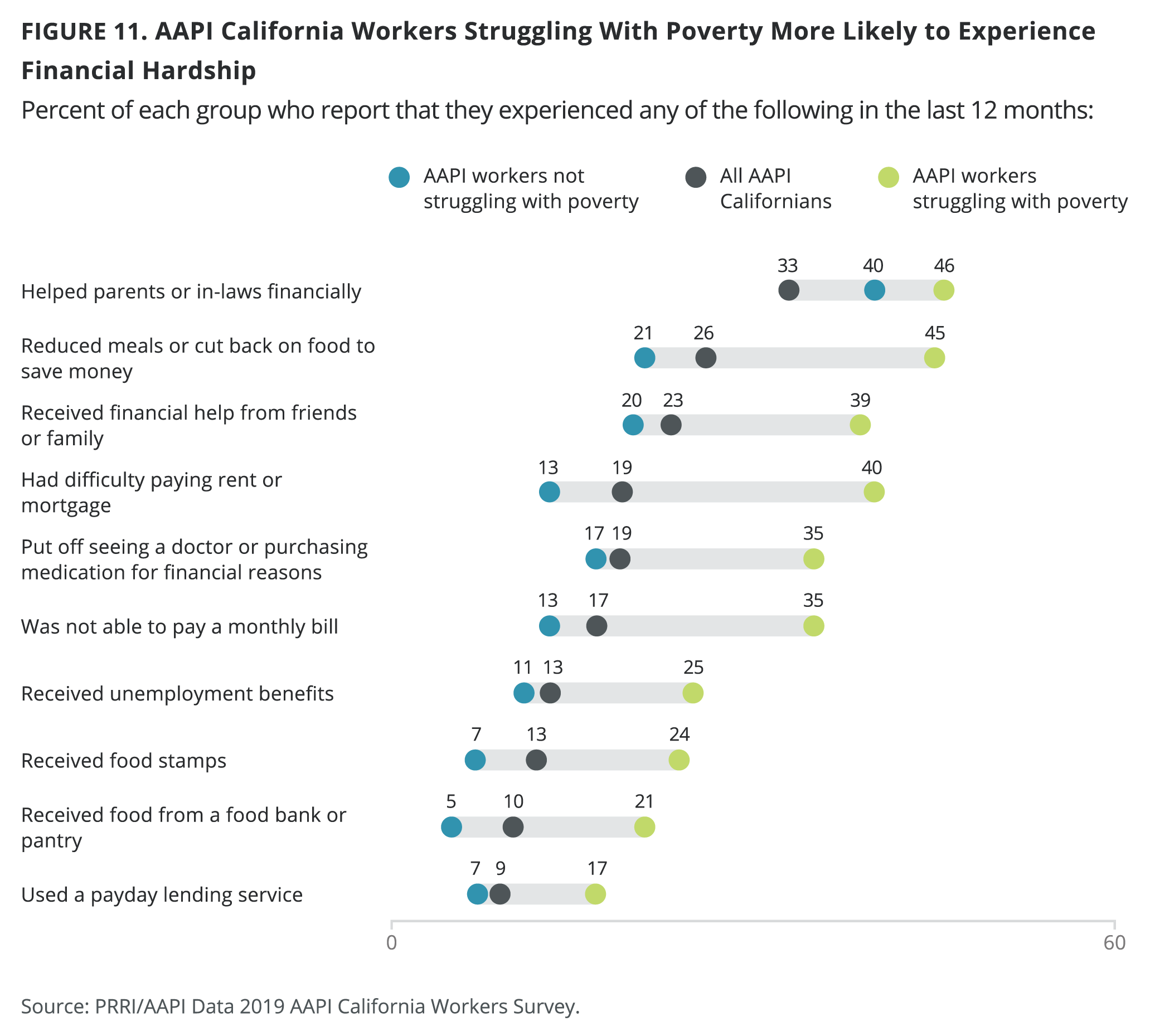
Student Loan Debt
Almost one in five (18%) AAPI Californians report currently having student loan debt. Among AAPI with student loan debt, about one-third (34%) owe less than $10,000, while more than four in ten (43%) have between $10,000 and $50,000 in debt. More than one in five (23%) owe more than $50,000. AAPI Californians are more likely to have student loan debt than Californians overall (14%).
The proportion of workers with student loan debt does not differ substantially between those who are struggling with poverty and those who are not. About one-quarter of workers both struggling with poverty (28%) and not struggling with poverty (22%) say they have student loan debt. Struggling workers owe less in debt than those who are not struggling. Almost half (47%) of struggling workers with student loan debt report that they owe less than $10,000, while non-struggling workers are much less likely (24%) to owe the same amount. Struggling workers are also far less likely to owe $50,000 or more in debt than non-struggling workers (15% vs. 30%). Despite owing more in student loans, non-struggling workers are more likely to have completed higher levels of education allowing for a greater likelihood that they would be financially secure.
Hmong and Native Hawaiian and Pacific Islander Californians are more likely than other ethnicities to report having student loan debt. About four in ten Hmong (42%) and Native Hawaiian and Pacific Islanders (40%) say they have debt compared to about one in five Cambodian (22%), Filipino (21%), Vietnamese (20%), Korean (19%), Indian (18%), and Japanese (16%) Californians. Just over one in ten (12%) Chinese say they also have student loan debt.
Younger AAPI Californians are also much more likely to report having student loan debt. About one-third (34%) of young AAPI (ages 18-29) say they have student loan debt compared to 23% of ages 30-49, 8% of those 50-64, and only 1% of seniors (ages 65 and over).
Concerns About Affordable Housing
While almost half (46%) of AAPI Californians are somewhat or very worried that they or someone in their family will be unable to afford housing, six in ten (61%) say it is somewhat or very difficult to find affordable housing in the places they want to live. AAPI Californians are less likely to be worried that they will be unable to afford housing than Californians overall (51%), though they are equally likely to say it is somewhat or very difficult to find affordable housing in the places they want to live.
Struggling workers (65%) are much more likely than non-struggling workers (46%) to say they are somewhat or very worried that they will be unable to afford housing, and that it is somewhat or very difficult to find affordable housing in the places they want to live (79% vs. 63%).
Concerns about housing vary considerably by ethnicity. More than six in ten Hmong (67%) and Native Hawaiian and Pacific Islanders (61%) are worried that they will be unable to afford housing as are slim majorities of Indians (51%) and Japanese (51%), and half (50%) of Filipinos. Fewer than half of Chinese (43%), Vietnamese (43%), Cambodian (41%), and Korean (33%) Californians share this concern.
About seven in ten NHPI (74%), Hmong (72%), Indian (69%), and Korean (65%) Californians say it has been difficult to find affordable housing in the places they want to live. Majorities of Japanese (60%), Chinese (59%), Filipinos (59%), Cambodians (58%), and Vietnamese (57%) Californians say the same.
Younger AAPI Californians are also much more likely to express concerns about finding housing than older Californians. A majority (56%) of AAPI ages 18-29 say they are somewhat or very worried that they will be unable to afford housing while 22% of seniors (ages 65 and over) share this concern. Additionally, while more than seven in ten (73%) young AAPI Californians consider it difficult to find affordable housing in the places they want to live, half as many seniors (39%) agree.
Women are also more likely to express greater concern about housing than men, though the divide is not as large as other demographics. Almost half (49%) of AAPI women say they are somewhat or very worried they will be unable to afford housing while 42% of men share this fear. Women (64%) are also more likely than men (57%) to say it has been difficult to find affordable housing in the places where they want to live at higher levels than men.
Concerns about housing also depend on the region. A majority of Inland Empire (57%) and the San Joaquin Valley (55%) residents are worried they will be unable to afford housing, while four in ten (41%) residents of the South Coast and Border share this concern. In this region, residents of Orange County (41%) and San Diego (41%) are equally likely to feel worried they will be unable to afford housing. Additionally, about seven in ten residents of Inland Empire (68%) say it has been difficult to find affordable housing in the places they want to live and about half (49%) of Sacramento Valley residents say the same.
Concerns About Health Insurance
About four in ten (41%) Asian American and Pacific Islander Californians say they are somewhat or very worried that they or someone in their family will lose their health insurance. AAPI Californians closely resemble Californians overall in their concern about losing health insurance (40%). Among workers, those who are struggling with poverty (60%) are much more likely than those who are not struggling (38%) to have this fear.
Concerns about losing health insurance vary by ethnicity. Majorities of Hmong (60%) and Native Hawaiian and Pacific Islanders (55%) are worried that they will lose their health insurance, as are around four in ten Indian (45%), Filipino (44%), Japanese (41%), Vietnamese (40%), and Chinese (39%) Californians. About one-third of Cambodians (36%) and Koreans (33%) are similarly concerned.
About one in five (20%) AAPI seniors (ages 65 and over) are concerned about losing their healthcare insurance compared to more than twice as many of every other age group.
There are notable differences in levels of concern about losing health insurance by region. Slim majorities of Inland Empire (55%) and the San Joaquin Valley (51%) residents say they are worried about losing their health insurance coverage, as are four in ten AAPIs living in Sacramento Valley (43%), Los Angeles (42%), the Bay Area (41%), and South Coast and Border (38%). In the South Coast and Border region, residents of Orange County (39%) and San Diego (38%) are similarly worried about losing their health insurance.
Concerns About Immigrant Status and Deportation
Asian American and Pacific Islander Californians are generally less concerned about immigration related issues compared to other fears. Still, one in ten AAPI Californians say they are somewhat or very worried that they or someone in their family will be deported (10%) or that they or someone in their household has felt vulnerable because of their immigration status (9%). AAPI Californians are less likely to worry that they will be deported than Californians overall (13%) and report this concern at much lower rates than Hispanic Californians (31%). AAPI Californians mirror the state population’s likelihood to feel vulnerable about their immigration status (9%), though they are half as likely to report feeling vulnerable as Hispanic Californians (18%).
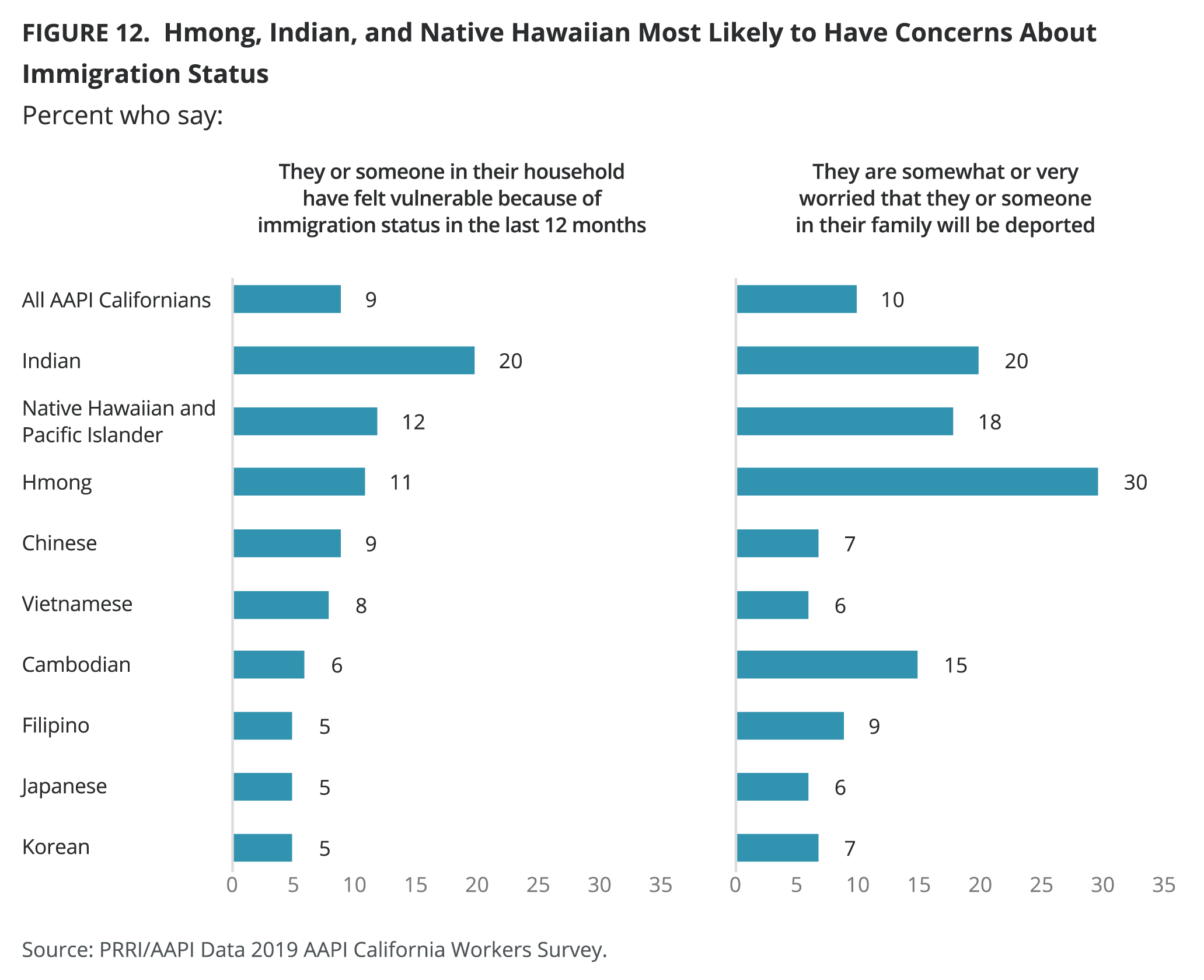
Struggling workers (17%) are about twice as likely as non-struggling workers (7%) to feel worried about being deported or say they felt vulnerable because of their immigration status (17% vs. 9%).
Hmong (30%) are by far the most likely to be worried about deportation followed by one in five or fewer Indians (20%), Native Hawaiian and Pacific Islanders (18%), and Cambodians (15%). Fewer than one in ten Filipinos (9%), Chinese (7%), Korean (7%), Japanese (6%), and Vietnamese (6%) share this concern.
Indians (20%) are the most likely to report feeling vulnerable because of their immigration status. About one in ten Native Hawaiian and Pacific Islander (12%), Hmong (11%), Chinese (9%), and Vietnamese (8%), Cambodians (6%), Filipinos (5%), and Japanese (5%) Californians say the same.
Interestingly, AAPI Californians born outside the United States are not more likely to be concerned about deportation or feel vulnerable because of their immigration status than those born in the US.
Younger AAPI Californians tend to express greater concern about deportation and their immigration status. More than one in ten young AAPI ages 18-29 (13%) are somewhat or very worried that they will be deported, while only 2% of seniors ages 65 and over share this fear. Furthermore, close to one in five (16%) of young AAPI say they or someone in their household feel vulnerable because of their immigration status, while almost no seniors report feeling vulnerable.
Covering a $400 Emergency Expense
Almost one in five (18%) Asian American and Pacific Islander Californians say that it would be either very difficult or nearly impossible to pay a $400 emergency expense. This proportion is almost identical to the number of Californians overall (17%) who say the same. Three in ten (30%) workers struggling with poverty, compared to 8% of those not struggling, report that it would be at least very difficult to pay such an expense.
One-third or more of Native Hawaiian and Pacific Islanders (37%), Cambodians (34%), and Hmong (33%) say it would be very difficult or nearly impossible to pay a $400 emergency expense, as do around one in five Vietnamese (24%), Filipino (19%), Indian (19%), and Japanese (16%) Californians. One in ten Chinese (12%) and Koreans (10%) also say it would be very difficult or nearly impossible to pay such an expense.
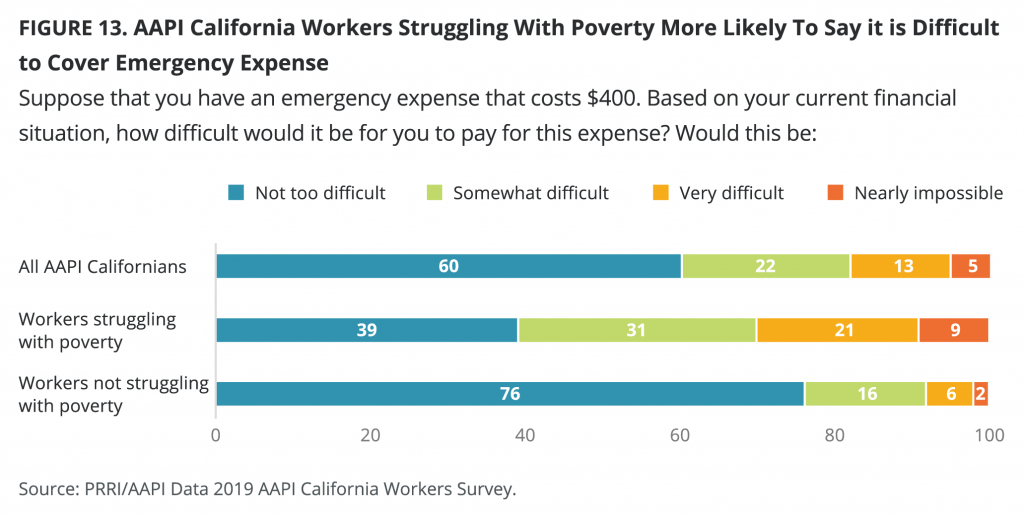
AAPI Californians with higher levels of educational attainment are much less likely to struggle with paying a $400 emergency expense. More than one-third (35%) of AAPI with a high school degree or less say it would be at least very difficult to pay such an expense while 14% of those with a college degree and 7% of postgraduates agree.
Though about one in five residents of most California regions say it would be at least very difficult to pay a $400 emergency expense, San Joaquin Valley residents are particularly likely to struggle with such an expense (42%).
Political Outlook and Engagement
Views of the Economic and Political System
Most Asian American and Pacific Islander Californians see American political and economic life as catering to the wealthy while being unresponsive to people like themselves. Two-thirds (67%) of AAPI Californians agree that the economic system in this country unfairly favors the wealthy. AAPI Californians are less likely than Californians overall (76%) to say the economic system unfairly favors the wealthy.
There is broad agreement among workers, regardless of whether they are struggling with poverty, about the unfairness of America’s economic and political system. At least three in four workers who are struggling with poverty (77%) and who are not struggling with poverty (75%) agree that the economic system in this country unfairly favors the wealthy.
AAPI Californians with a high school degree or less are less likely than AAPI Californians with higher levels of educational attainment to hold these more cynical views of the economic and political system. About seven in ten AAPI with some college experience (69%) or higher (70%) think the economic system unfairly favors the wealthy, a slim majority (51%) of those with a high school degree or less agree.
About eight in ten Japanese (82%) and Indian (77%) Californians say that the economic system in the United States unfairly favors the wealthy as do majorities of Native Hawaiian and Pacific Islanders (73%), Chinese (71%), Hmong (70%), Filipinos (66%), Koreans (61%), and Cambodians (57%). Less than half (45%) of Vietnamese also think the system unfairly favors the wealthy.
Turning to the political system, more than six in ten (63%) AAPI agree that public officials do not care much about what people like them think, while a majority (53%) of AAPI Californians say that it does not matter if they vote because politics and elections are controlled by people with money and big corporations. AAPI Californians are less likely than Californians overall to think public officials do not care much about what people like them think (70%), though they are equally likely as all Californians (52%) to say politics and elections are controlled by people with money and big corporations so it does not matter if they vote. The high levels of skepticism about the system’s fairness are notable among this largely immigrant group.
About seven in ten workers struggling with poverty (71%) and not struggling (72%) say public officials do not care much about what people like them think. However, struggling workers (65%) are more likely than workers who are not struggling (55%) to think that their vote does not count due to politics and elections being controlled by people with money and big corporations.
Just under half (48%) of those with a high school education or less say public officials do not care what people like them think compared to about two-thirds of those with some college (65%), college graduates (66%) and postgraduates (68%). Less than half (48%) of those with a high school education or less also say that their vote does not matter, compared to majorities of other educational groups (57%, 52%, 56%, respectively).
About seven in ten Japanese (72%) and Chinese (70%) Californians say public officials do not care what people like them think, as do smaller majorities of Filipinos (64%), Koreans (64%), Indians (63%), NHPI (62%), Hmong (58%), and Cambodians (51%). About four in ten (39%) Vietnamese also say that public officials do not care what people like them think.
Additionally, about six in ten Indian (60%), Chinese (59%), and NHPI (58%) Californians say that politics and elections are controlled by people with money and big corporations as do smaller majorities of Filipinos (53%), Japanese (53%), and Hmong (51%). Just under half of Cambodians (49%) and Koreans (48%) also hold this view, while about one-third (35%) of Vietnamese think that people with money and big corporations control politics and elections.
Workers Organizing
About seven in ten (69%) AAPI Californians agree that it is important for workers to organize so that employers do not take advantage of them. AAPI Californians are slightly less likely to hold this view than Californians as a whole (73%).
Struggling (76%) and non-struggling (74%) AAPI workers are equally likely to think it is important for workers to organize, though struggling workers are more likely to completely agree that it is important for workers to organize than non-struggling workers (36% vs. 25%). Unsurprisingly, union members are much more likely to think it is important for workers to organize than non-union members (85% vs. 71%).
A majority (53%) of those with a high school degree or less believe that it is important for workers to organize, compared to more than seven in ten of every other educational group.
While about seven in ten of most age groups, including young AAPI ages 18-29 (77%) think it is important for workers to organize, a smaller majority (52%) of seniors agree.
Almost eight in ten Indian (79%), Native Hawaiian and Pacific Islander (79%), Filipino (77%), and Japanese (77%) Californians think that it is important for workers to organize so that employers do not take advantage of them, while smaller majorities of Hmong (71%), Cambodians (68%), Chinese (63%), Koreans (63%), and Vietnamese (54%) agree.
Civic and Political Engagement
Most Asian American and Pacific Islander Californians do not report engaging in civic or political activities in the last 12 months. Less than one-quarter (23%) have signed a voter petition, while even fewer attended a public meeting such as for a school board or city council (16%) or contacted their representative or a government official (10%).
Relatively few AAPI Californians engaged in any combination of these three activities over the past year. Two in three (66%) AAPI report engaging in none of these activities. About one in five (22%) have engaged in one activity, while less than one in ten have participated in two (7%) or three (4%) activities. AAPI Californians are more likely to have participated in one activity than Californians overall (17%), but less likely to have participated in two (9%) or three (9%) activities.
AAPI Workers who are struggling with poverty are not particularly more or less likely to participate in civic activities than more financially secure workers.
U.S.-born residents (44%) are much more likely than foreign-born residents (30%) to be involved in at least one type of civic or political action. A majority (51%) of Native Hawaiians and Pacific Islanders have engaged in at least one civic activity, as have about four in ten Japanese (42%), Korean (42%), Indian (41%), and Hmong (37%) Californians. Additionally, about one-third of Cambodians (34%), Vietnamese (34%), Filipinos (30%), and Chinese (28%) report participating in at least one civic activity.
About half (49%) of San Joaquin Valley residents have participated in at least one civic or political action compared to about one-third of residents of every other region.
A majority (56%) of AAPI Californians report donating money to a religious or charitable cause, while 40% say they have not.
Not surprisingly given their more limited economic resources, workers who are struggling with poverty (49%) are much less likely to report such donations than workers not struggling with poverty (61%).
Majorities of Cambodian (65%), Korean (64%), Filipino (63%), Indian (62%), NHPI (61%), Japanese (56%), and Vietnamese (56%) Californians all say they have donated money to a religious or charitable cause in the last year. About four in ten Chinese (44%) and Hmong (37%) report the same.
The likelihood of giving such donations increases with higher levels of education. AAPI Californians with a high school degree or less (37%) are much less likely to give donations than postgraduates (63%).
Conclusion and Recommendations for Further Research
The 2019 AAPI Survey of California workers paints a detailed picture of two AAPI Californians, one that is economically secure and one that is working and struggling with poverty. Although statistical averages show that AAPIs as a whole exhibit high-levels of employment and earning power, this report reveals that nearly one in four California AAPIs is working and struggling with poverty. Hmong and Native Hawaiian Pacific Islander Californians are the groups most likely to be working and struggling with poverty.
More than eight in ten Native Hawaiian and Pacific Islanders (82%) report that they experienced economic hardships, like being unable to pay a monthly bill or having to use food stamps, as have about seven in ten Hmong (76%), Cambodians (71%), and Vietnamese (70%). At the same time, no AAPI group is untouched by financial precarity. Chinese, Indians, and Filipinos are less likely to experience economic struggle than most Californians, but as the most populous groups of AAPIs in the state, they still make up more than half of all AAPIs working and struggling with poverty. There is some indication that it is those Chinese who are U.S.-born and possess lower levels of education are more likely to fall into this category than those who are foreign-born or demonstrate higher levels of education.
U.S. immigration policies play a significant role in shaping the financial well-being of AAPI California workers. Groups like Chinese, Indians, and Filipinos, which have been most likely to benefit from U.S. immigration policies that recruit highly educated workers, are far less likely to be working and struggling with poverty or facing economic hardship than those groups that have come as refugees to the United States as a result of U.S. wartime activity (Vietnamese, Cambodians, Hmong) and territorial expansion (NHPIs). Even family visas tend to perpetuate these class disparities, as family members related to high-skill professionals tend to have a higher level of educational attainment before immigrating to the United States.
Despite higher overall levels of financial security than the average Californian, a majority of AAPI Californians question the “bootstrap” narrative that “hard work and determination alone” guarantee success for most people. They also strongly support the idea that it is important for workers to organize so that employers do not take advantage of them. These opinions may be tied to experiences and awareness of racial discrimination among California AAPIs, who are more likely to report experiencing racial discrimination (17%) than Californians as a whole (12%).
Looking ahead, it is important to grow investments in policy research and community research that shine a light on Asian American and Pacific Islander communities that are struggling to keep up with the California dream. This is particularly important given that AAPIs represent about one in six residents in California and are the fastest growing groups in the state. Survey research, administrative data collections, and community-engaged research are all vital to understand the evolving needs of AAPI populations. Relatedly, research investments by government and philanthropy that fail to meaningfully include Asian Americans and Pacific Islanders end up missing out on important segments of the California population.
This report provides a more expansive view of what it means to struggle economically compared with the official federal poverty measures. It shows that economic fragility in California extends even to groups like AAPIs that possess, on average, the highest overall levels of education and income of any racial group in the state. It is more important than ever to formulate policies and make philanthropic investments that address the challenges of AAPIs who are working and struggling with poverty.
Investments that generally focus on Pacific Islanders and Southeast Asian populations such as Hmong and Cambodians are more likely to help community members who are struggling with poverty. At the same time, an exclusive focus on these communities would fail to capture over 90% of the AAPI population in California that is working and struggling with poverty. Thus, investments and policy solutions also need to extend to larger AAPI populations such as Chinese, Filipinos, Indians, Vietnamese, and Koreans.
With stereotypes of the “model minority myth” that paint the entire AAPI population as highly educated and financially stable, little attention is paid to those who struggle economically, who make up nearly a quarter of AAPI Californians and nearly four in ten AAPI workers. Without attention to segments of the AAPI community that are being left behind, we risk further delaying the dream of a California that provides mobility and prosperity for all.
Survey Methodology
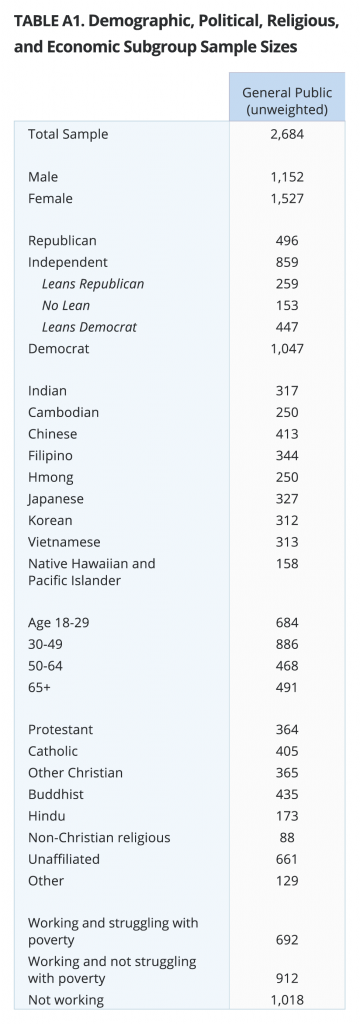
The AAPI California Workers Survey was jointly designed by PRRI and AAPI Data and was made possible by a generous grant from the James Irvine Foundation. Results of the survey are based on interviews conducted by telephone and online from July 6 to September 6, 2019. Results are presented for 2,684 Asian American or Pacific Islander adults surveyed, producing an overall margin of sampling error of +/- 3.1% (including the design effect). Sampling was targeted towards the eight largest Asian national origin groups and Pacific Islanders that together account for 84% of the AAPI adult resident population (and 83% of the AAPI adult citizen population).
Telephone interviews were conducted in 7 languages (English, Cantonese, Mandarin, Korean, Vietnamese, Hmong, Cambodian) – chosen according to the interviewee’s preference. The survey included Native Hawaiian/Pacific Islanders and 8 Asian national origin groups (Chinese, Filipino, Indian, Vietnamese, Korean, Japanese, Hmong, and Cambodian). Forty-seven percent of the adult citizen surveys were conducted by telephone, and of these, 53% of interviews were conducted in an Asian language; the online surveys were conducted entirely in English.
The primary sampling strategy for 2,509 of the interviews was to interview individuals drawn from a random selection of respondents in a listed sample stratified by national origin. Samples included registered voter and commercial vendor lists classified by ethnic name (first, middle, and/or last) and tract-level ethnic concentration. Interviews were conducted by ISA (Interviewing Services of America), located in Van Nuys, CA. In addition, ISA partnered with various online sample vendors that have reliable panels of Asian American and Pacific Islander populations who are able to take responses in English. Younger Asian Americans and native-born Asian Americans are more likely to be part of the online sample and help correct the biases of telephone-only interviews that skew older and more foreign-born.
The additional 175 interviews were conducted among Californians who identify as AAPI in Ipsos’s Knowledge Panel. Respondents are recruited to the KnowledgePanel using an addressed-based sampling methodology from the Delivery Sequence File of the USPS – a database with full coverage of all delivery addresses in the U.S. As such, it covers all households regardless of their phone status, providing a representative online sample. Unlike opt-in panels, households are not permitted to “self-select” into the panel; and are generally limited to how many surveys they can take within a given time period. The survey invitation was sent to all AAPI Californians in the sample.
The data are weighted to Census parameters to statistically account for any demographic differences of interest between the sample and population parameters for analyses of the AAPI population, as well as for subgroups of the population, on the following dimensions: size of group within a region, educational attainment, gender, age, and nativity. Defined regions include: Bay Area, Central Valley, Inland Empire, Los Angeles County, Orange County, San Diego, and other parts of California.
The sample sizes by ethnicity are as follows, along with an estimation of the margin of error associated with each sample size (in parentheses):
Asian Indian: 317 (+/- 6%)
Cambodian: 250 (+/-7%)
Chinese: 413 (+/- 5%)
Filipino: 344 (+/- 5.5%)
Japanese: 327 (+/- 6%)
Korean: 312 (+/- 6%)
Vietnamese: 313 (+/- 6%)
Native Hawaiian/Pacific Islander: 158 (+/- 8%)
Sampling error from the size of the sample is only one type of error possible in surveys. Findings may also be subject to variation from question wording, question order, and the time and date when the survey was conducted.
Endnotes
[1] PRRI 2018 California Workers Survey.
[2] Source: https://www.census.gov/topics/population/race/about.html
[3] Ramakrishnan and Lewis 2004, Asian Americans Advancing Justice-AAJC 2018.
[4] “Untapped Power: The Strength of Asian American, Native Hawaiian, and Pacific Islander Working People,” Asian Pacific American Labor Alliance, https://www.apalanet.org/untapped-power.html
[5] PRRI 2018 California Workers Survey. All references to all Californians, or California workers, refer to this study. https://www.prri.org/research/renewed_struggle_for_the_american_dream-prri_2018_california_workers_survey/
[6] This includes AAPI Californians who are retired, homemakers or stay at home parents, students, and people who are unemployed and not looking for work, disabled, or who refused to answer the question.
[7] In this survey, respondents are asked if they have experienced some form of gender discrimination or sexual harassment in the workplace in a single item, in the 2018 California Workers Survey, respondents were asked separate questions about experiencing gender discrimination and sexual harassment in the workplace.
[8] Participants in the gig economy include both working and non-working AAPI Californians. Among working AAPIs who participate in the gig economy, it is unknown whether the experiences they report come from their gig jobs or other jobs.
Citation
Recommended citation:
“The Working Lives and Struggles of Asian Americans and Pacific Islanders in California” PRRI (November 18, 2019). https://www.prri.org/research/the-working-lives-and-struggles-of-asian-americans-and-pacific-islanders-in-california/
